Exhibit 99.2
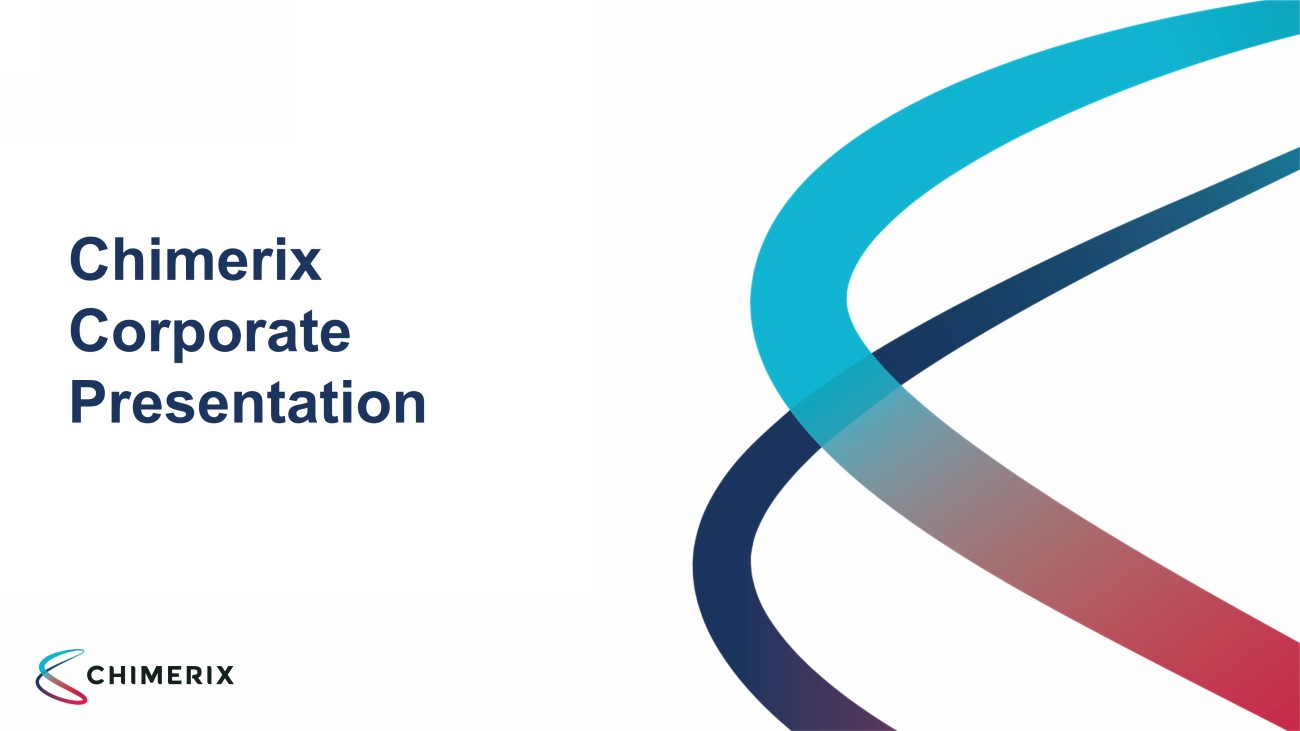
Chimerix Corporate Presentation
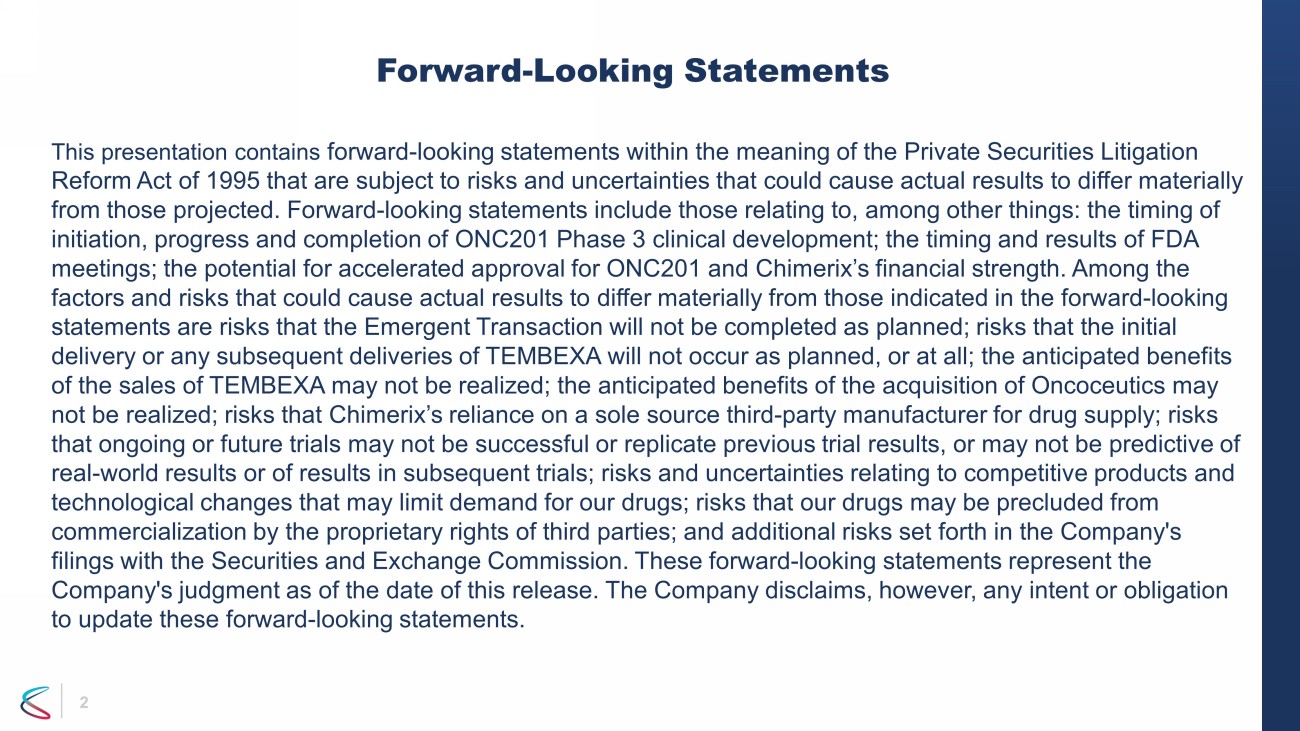
2 2 Forward - Looking Statements This presentation contains forward - looking statements within the meaning of the Private Securities Litigation Reform Act of 1995 that are subject to risks and uncertainties that could cause actual results to differ materially from those projected. Forward - looking statements include those relating to, among other things: the timing of initiation, progress and completion of ONC201 Phase 3 clinical development; the timing and results of FDA meetings; the potential for accelerated approval for ONC201 and Chimerix’s financial strength. Among the factors and risks that could cause actual results to differ materially from those indicated in the forward - looking statements are risks that the Emergent Transaction will not be completed as planned; risks that the initial delivery or any subsequent deliveries of TEMBEXA will not occur as planned, or at all; the anticipated benefits of the sales of TEMBEXA may not be realized; the anticipated benefits of the acquisition of Oncoceutics may not be realized; risks that Chimerix’s reliance on a sole source third - party manufacturer for drug supply; risks that ongoing or future trials may not be successful or replicate previous trial results, or may not be predictive of real - world results or of results in subsequent trials; risks and uncertainties relating to competitive products and technological changes that may limit demand for our drugs; risks that our drugs may be precluded from commercialization by the proprietary rights of third parties; and additional risks set forth in the Company's filings with the Securities and Exchange Commission. These forward - looking statements represent the Company's judgment as of the date of this release. The Company disclaims, however, any intent or obligation to update these forward - looking statements.
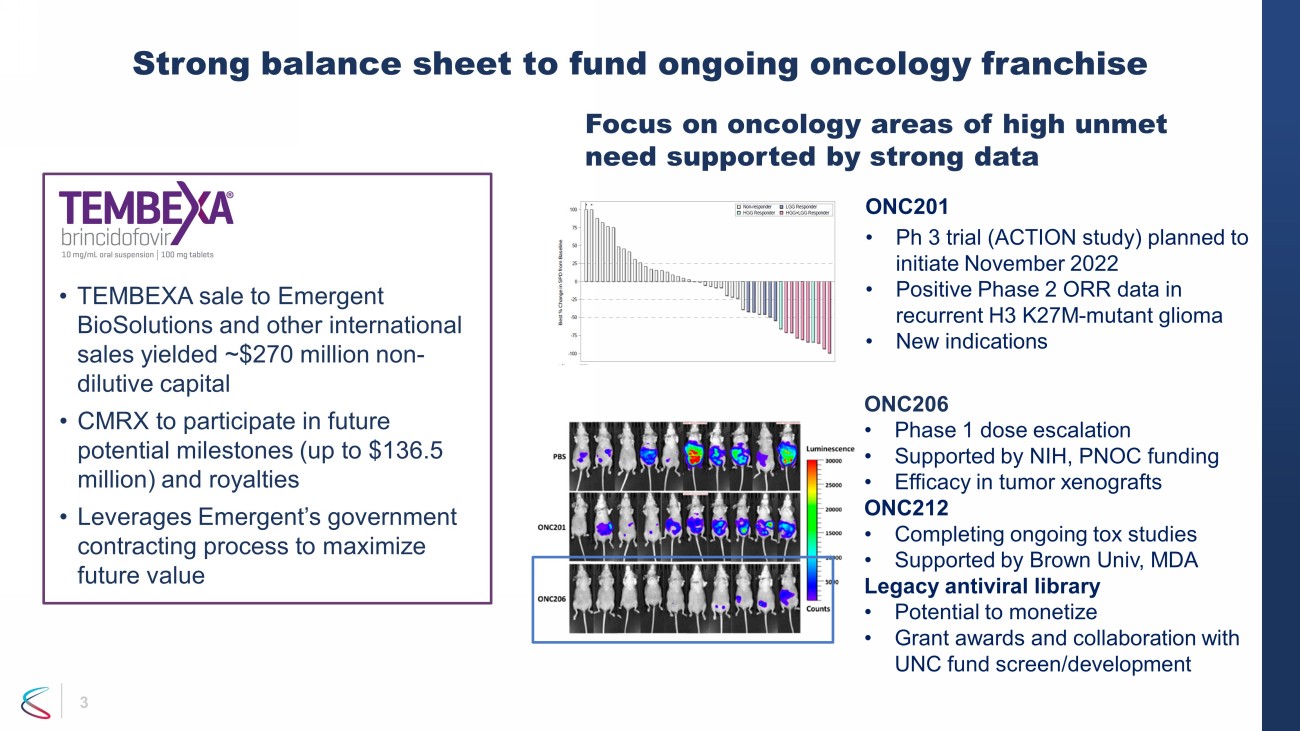
3 Strong balance sheet to fund ongoing oncology franchise Focus on oncology areas of high unmet need supported by strong data ONC201 • Ph 3 trial (ACTION study) planned to initiate November 2022 • Positive Phase 2 ORR data in recurrent H3 K27M - mutant glioma • New indications ONC206 • Phase 1 dose escalation • Supported by NIH, PNOC funding • Efficacy in tumor xenografts ONC212 • Completing ongoing tox studies • Supported by Brown Univ, MDA Legacy antiviral library • Potential to monetize • Grant awards and collaboration with UNC fund screen/development • TEMBEXA sale to Emergent BioSolutions and other international sales yielded ~$270 million non - dilutive capital • CMRX to participate in future potential milestones (up to $136.5 million) and royalties • Leverages Emergent’s government contracting process to maximize future value
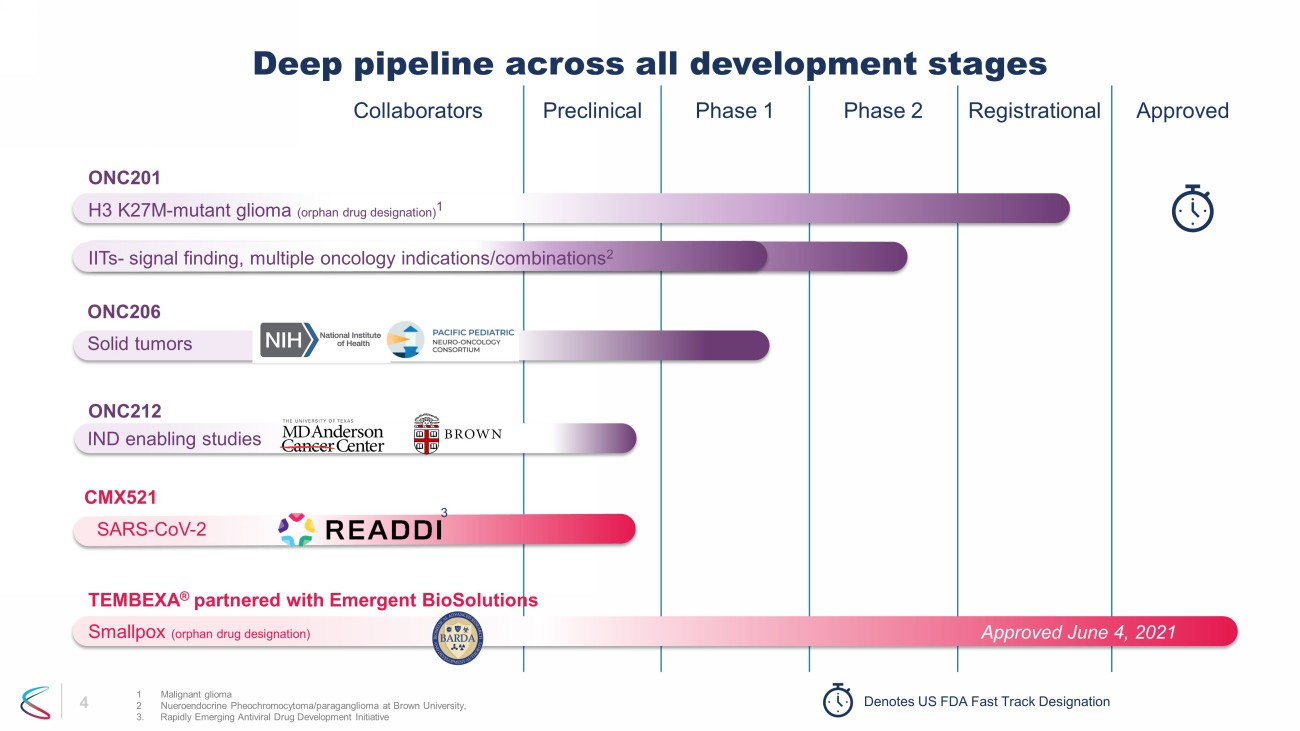
4 Collaborators Preclinical Phase 1 Phase 2 Registrational Approved Deep pipeline across all development stages 1 Malignant glioma 2 Nueroendocrine Pheochromocytoma/paraganglioma at Brown University, 3. Rapidly Emerging Antiviral Drug Development Initiative Denotes US FDA Fast Track Designation IND enabling studies ONC212 ONC201 H3 K27M - mutant glioma (orphan drug designation) 1 IITs - signal finding, multiple oncology indications/combinations 2 Solid tumors ONC206 CMX521 SARS - CoV - 2 3 TEMBEXA ® partnered with Emergent BioSolutions Smallpox (orphan drug designation) Approved June 4, 2021
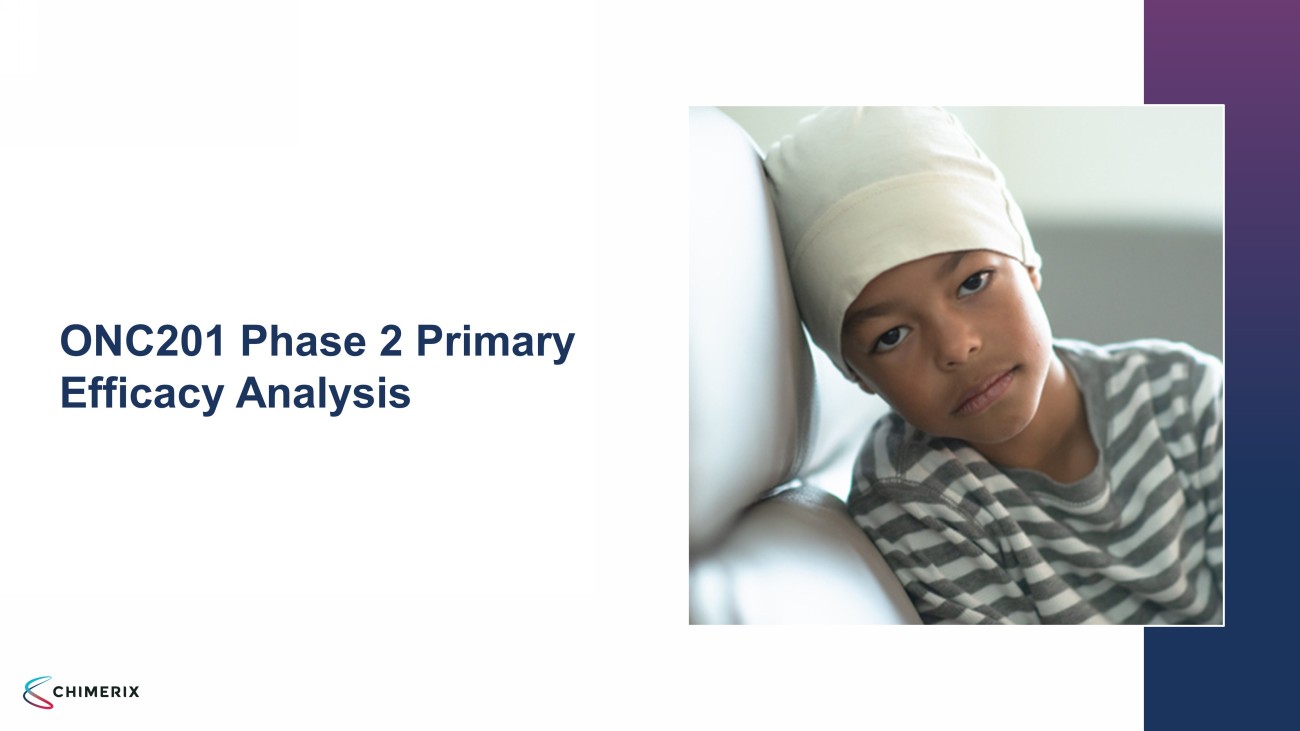
ONC201 Phase 2 Primary Efficacy Analysis
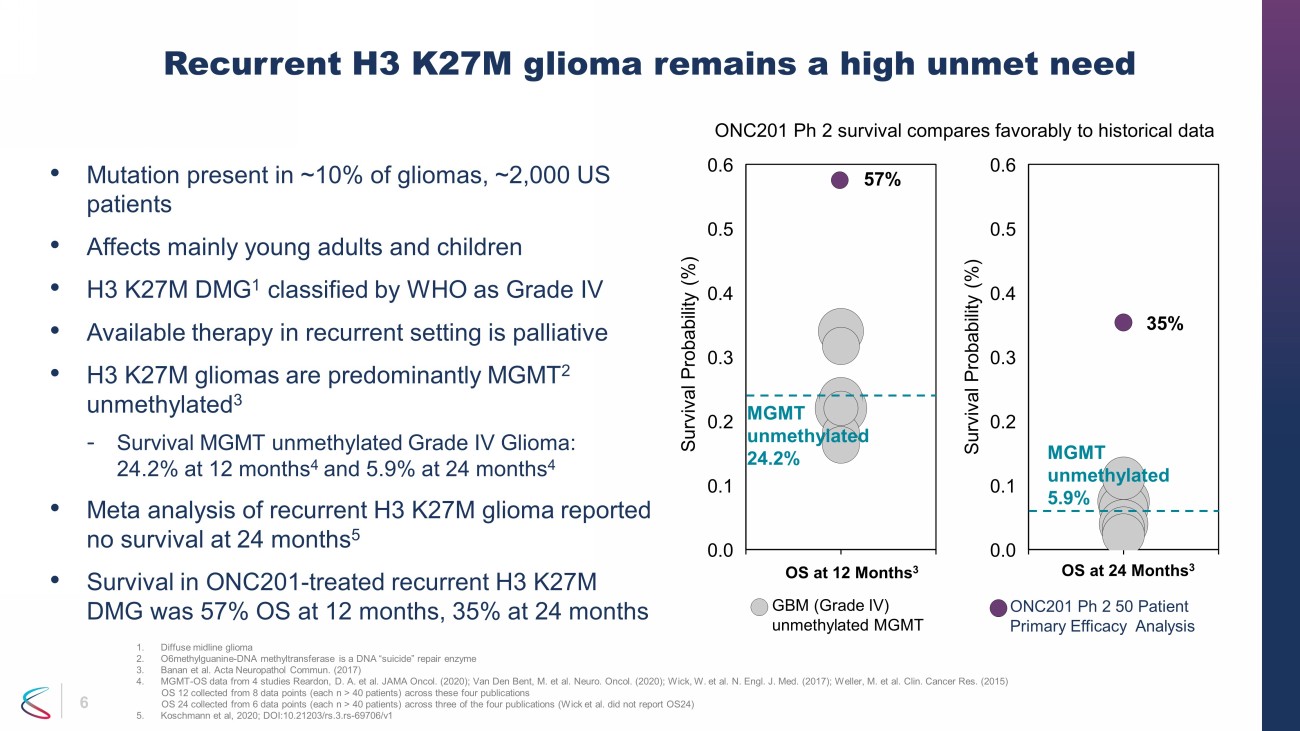
6 • Mutation present in ~10% of gliomas, ~2,000 US patients • Affects mainly young adults and children • H3 K27M DMG 1 classified by WHO as Grade IV • Available therapy in recurrent setting is palliative • H3 K27M gliomas are predominantly MGMT 2 unmethylated 3 - Survival MGMT unmethylated Grade IV Glioma: 24.2% at 12 months 4 and 5.9% at 24 months 4 • Meta analysis of recurrent H3 K27M glioma reported no survival at 24 months 5 • Survival in ONC201 - treated recurrent H3 K27M DMG was 57% OS at 12 months, 35% at 24 months Recurrent H3 K27M glioma remains a high unmet need 1. Diffuse midline glioma 2. O6methylguanine - DNA methyltransferase is a DNA “suicide” repair enzyme 3. Banan et al. Acta Neuropathol Commun. (2017) 4. MGMT - OS data from 4 studies Reardon, D. A. et al. JAMA Oncol. (2020); Van Den Bent, M. et al. Neuro. Oncol. (2020); Wick, W. et al. N. Engl. J. Med. (2017); Weller, M. et al. Clin. Cancer Res . (2015) OS 12 collected from 8 data points (each n > 40 patients) across these four publications OS 24 collected from 6 data points (each n > 40 patients) across three of the four publications (Wick et al. did not report O S24 ) 5. Koschmann et al, 2020; DOI:10.21203/rs.3.rs - 69706/v1 57% 0.5 0.2 OS at 12 Months 3 0.3 0.0 0.1 0.4 0.6 Survival Probability (%) GBM (Grade IV) unmethylated MGMT 35% 0.1 0.3 OS at 24 Months 3 0.0 0.6 0.2 0.4 0.5 Survival Probability (%) MGMT unmethylated 24.2% MGMT unmethylated 5.9% ONC201 Ph 2 survival compares favorably to historical data ONC201 Ph 2 50 Patient Primary Efficacy Analysis
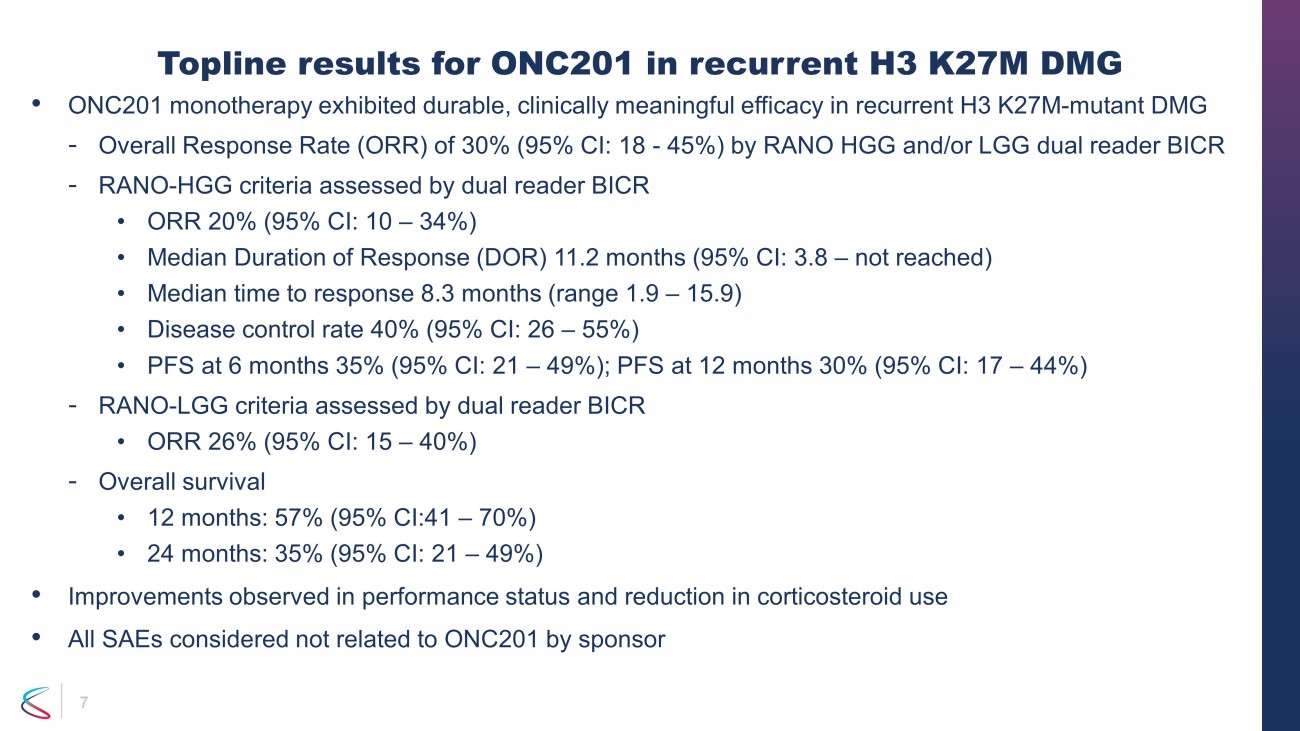
7 • ONC201 monotherapy exhibited durable, clinically meaningful efficacy in recurrent H3 K27M - mutant DMG - Overall Response Rate (ORR) of 30% (95% CI: 18 - 45%) by RANO HGG and/or LGG dual reader BICR - RANO - HGG criteria assessed by dual reader BICR • ORR 20% (95% CI: 10 – 34%) • Median Duration of Response (DOR) 11.2 months (95% CI: 3.8 – not reached) • Median time to response 8.3 months (range 1.9 – 15.9) • Disease control rate 40% (95% CI: 26 – 55%) • PFS at 6 months 35% (95% CI: 21 – 49%); PFS at 12 months 30% (95% CI: 17 – 44%) - RANO - LGG criteria assessed by dual reader BICR • ORR 26% (95% CI: 15 – 40%) - Overall survival • 12 months: 57% (95% CI:41 – 70%) • 24 months: 35% (95% CI: 21 – 49%) • Improvements observed in performance status and reduction in corticosteroid use • All SAEs considered not related to ONC201 by sponsor Topline results for ONC201 in recurrent H3 K27M DMG
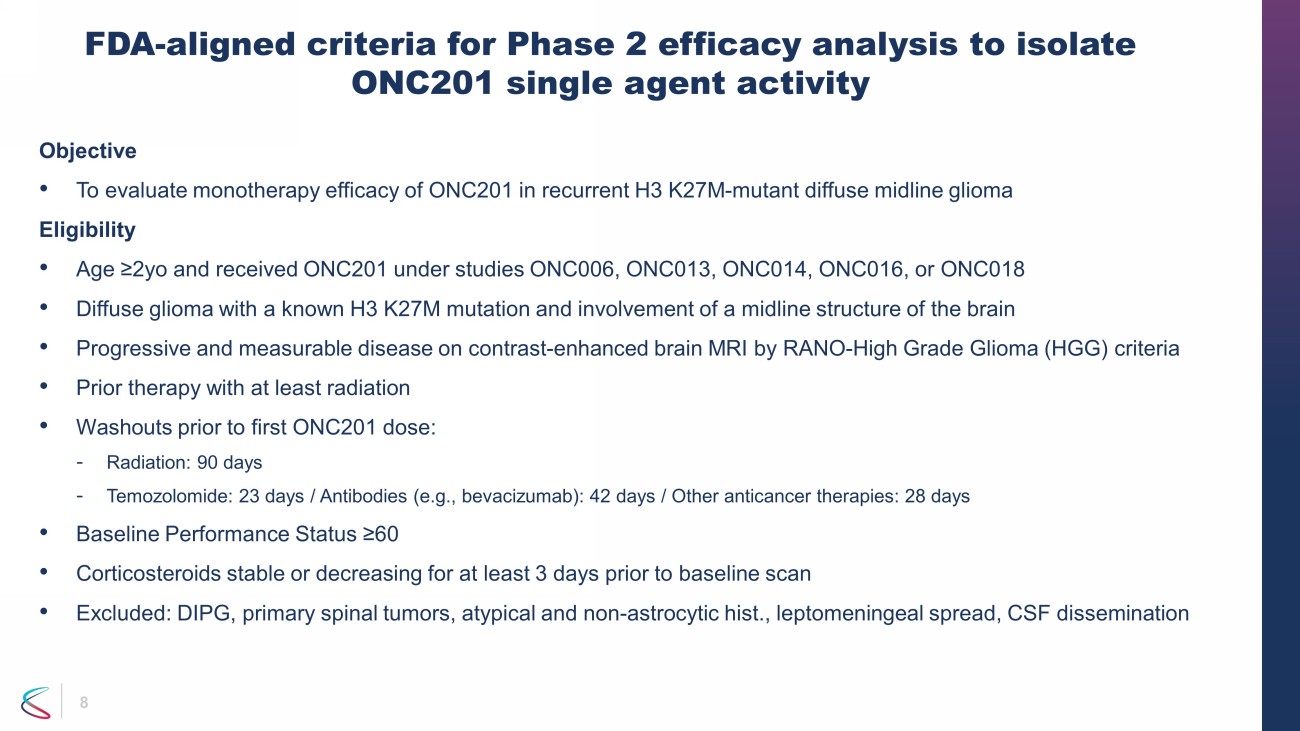
8 Objective • To evaluate monotherapy efficacy of ONC201 in recurrent H3 K27M - mutant diffuse midline glioma Eligibility • Age ≥2yo and received ONC201 under studies ONC006, ONC013, ONC014, ONC016, or ONC018 • Diffuse glioma with a known H3 K27M mutation and involvement of a midline structure of the brain • Progressive and measurable disease on contrast - enhanced brain MRI by RANO - High Grade Glioma (HGG) criteria • Prior therapy with at least radiation • Washouts prior to first ONC201 dose: - Radiation: 90 days - Temozolomide: 23 days / Antibodies (e.g., bevacizumab): 42 days / Other anticancer therapies: 28 days • Baseline Performance Status ≥60 • Corticosteroids stable or decreasing for at least 3 days prior to baseline scan • Excluded: DIPG, primary spinal tumors, atypical and non - astrocytic hist., leptomeningeal spread, CSF dissemination FDA - aligned criteria for Phase 2 efficacy analysis to isolate ONC201 single agent activity
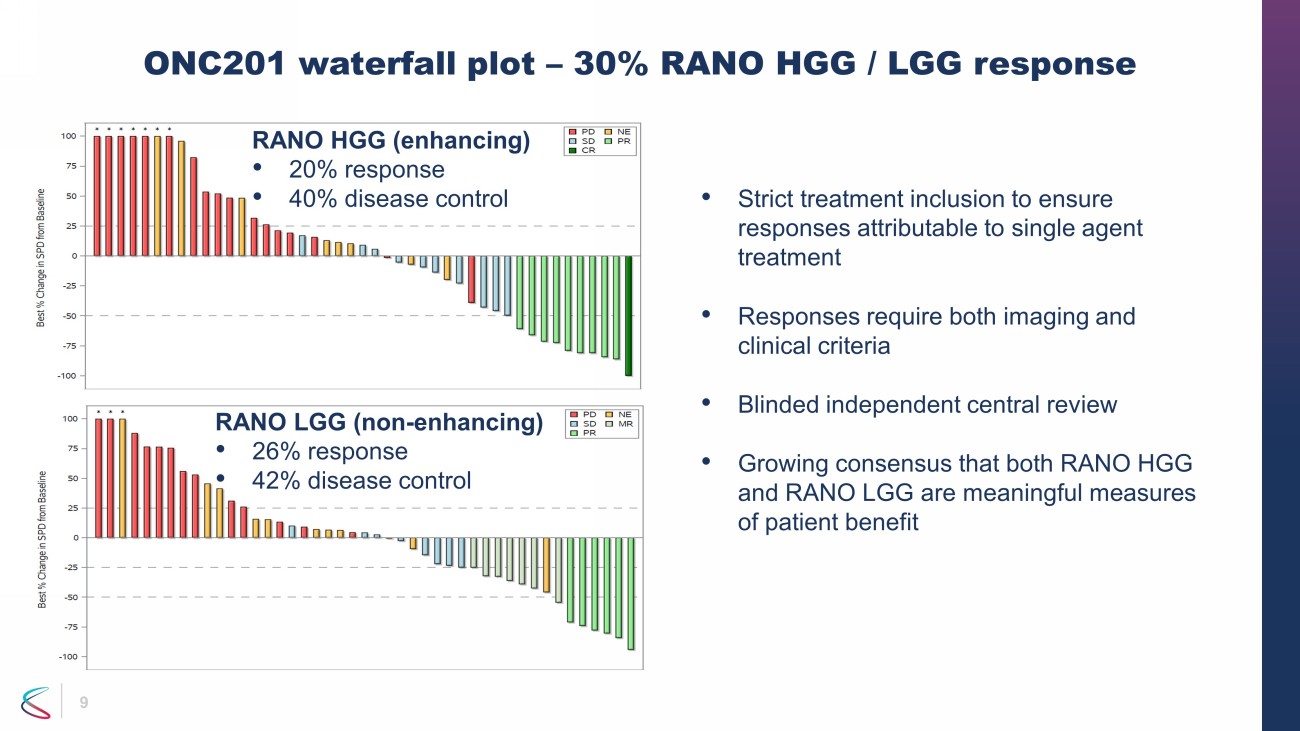
9 • Strict treatment inclusion to ensure responses attributable to single agent treatment • Responses require both imaging and clinical criteria • Blinded independent central review • Growing consensus that both RANO HGG and RANO LGG are meaningful measures of patient benefit ONC201 waterfall plot – 30% RANO HGG / LGG response RANO HGG (enhancing) • 20% response • 40% disease control RANO LGG (non - enhancing) • 26% response • 42% disease control
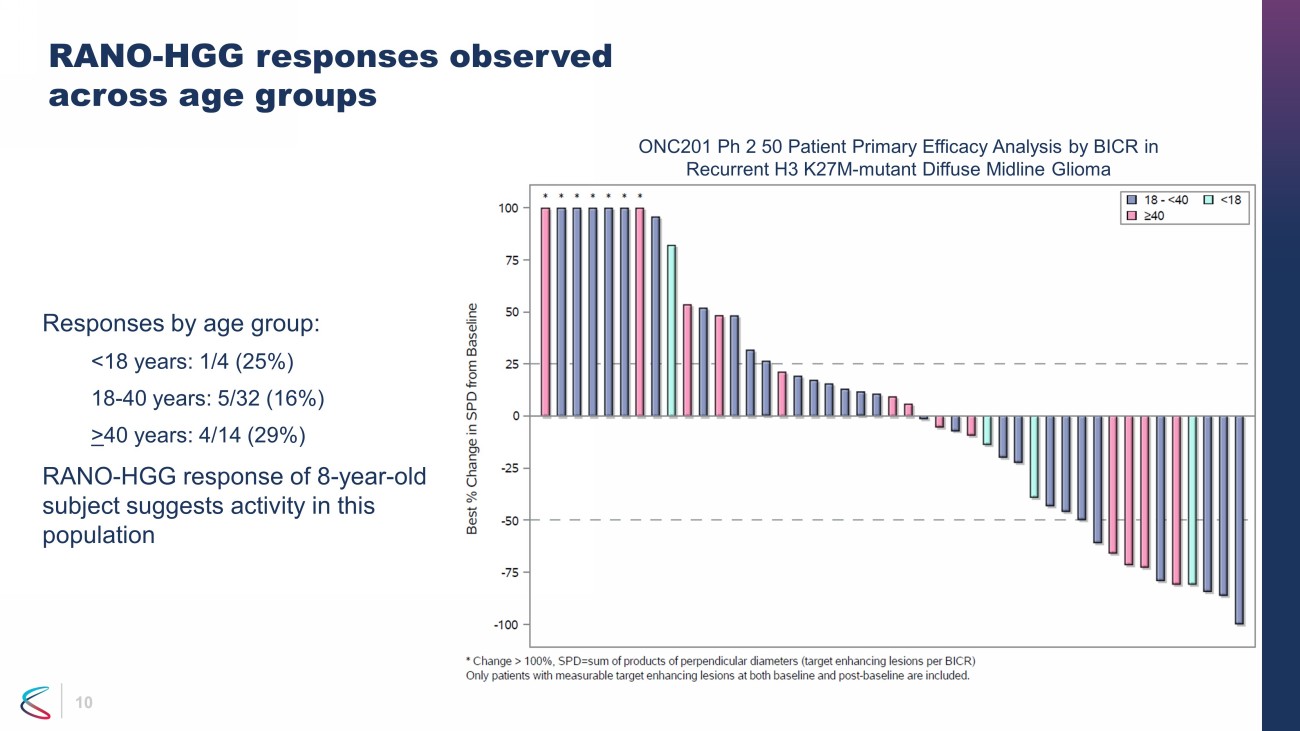
10 10 RANO - HGG responses observed across age groups Responses by age group: <18 years: 1/4 (25%) 18 - 40 years: 5/32 (16%) > 40 years: 4/14 (29%) RANO - HGG response of 8 - year - old subject suggests activity in this population ONC201 Ph 2 50 Patient Primary Efficacy Analysis by BICR in Recurrent H3 K27M - mutant Diffuse Midline Glioma
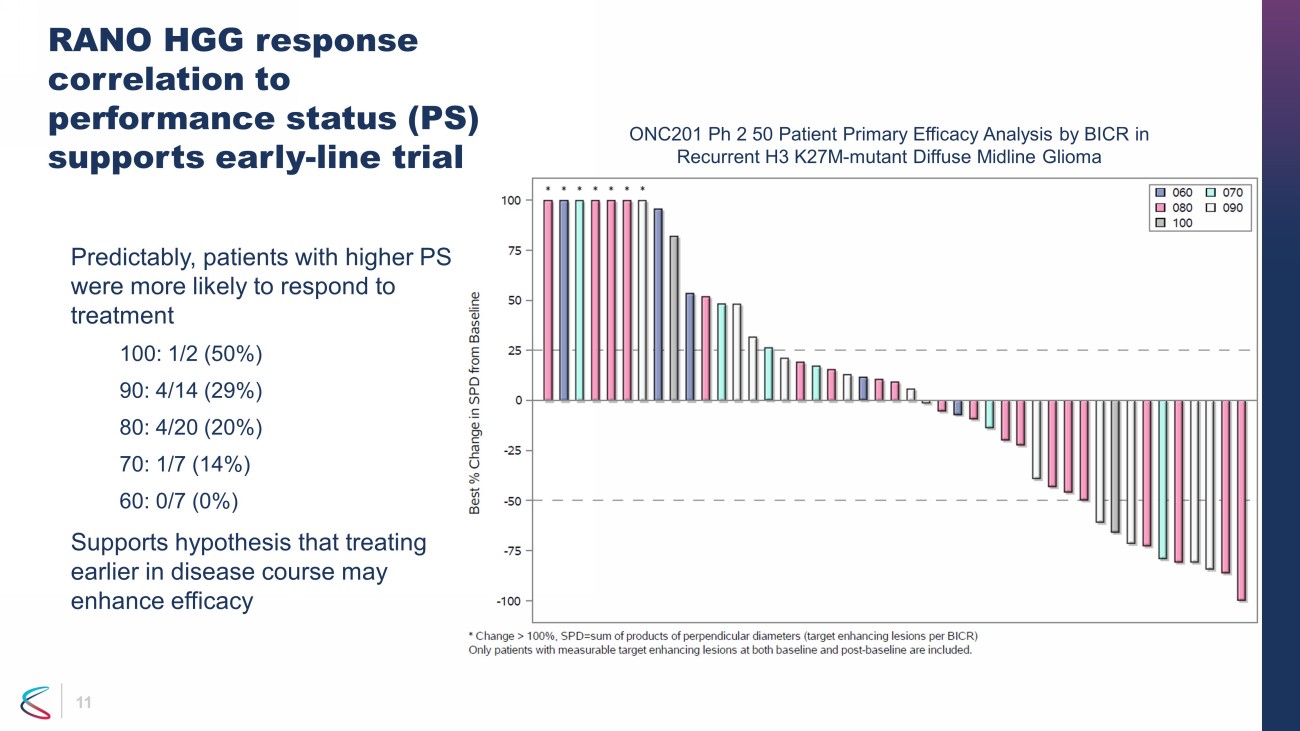
11 11 RANO HGG response correlation to performance status (PS) supports early - line trial Predictably, patients with higher PS were more likely to respond to treatment 100: 1/2 (50%) 90: 4/14 (29%) 80: 4/20 (20%) 70: 1/7 (14%) 60: 0/7 (0%) Supports hypothesis that treating earlier in disease course may enhance efficacy ONC201 Ph 2 50 Patient Primary Efficacy Analysis by BICR in Recurrent H3 K27M - mutant Diffuse Midline Glioma
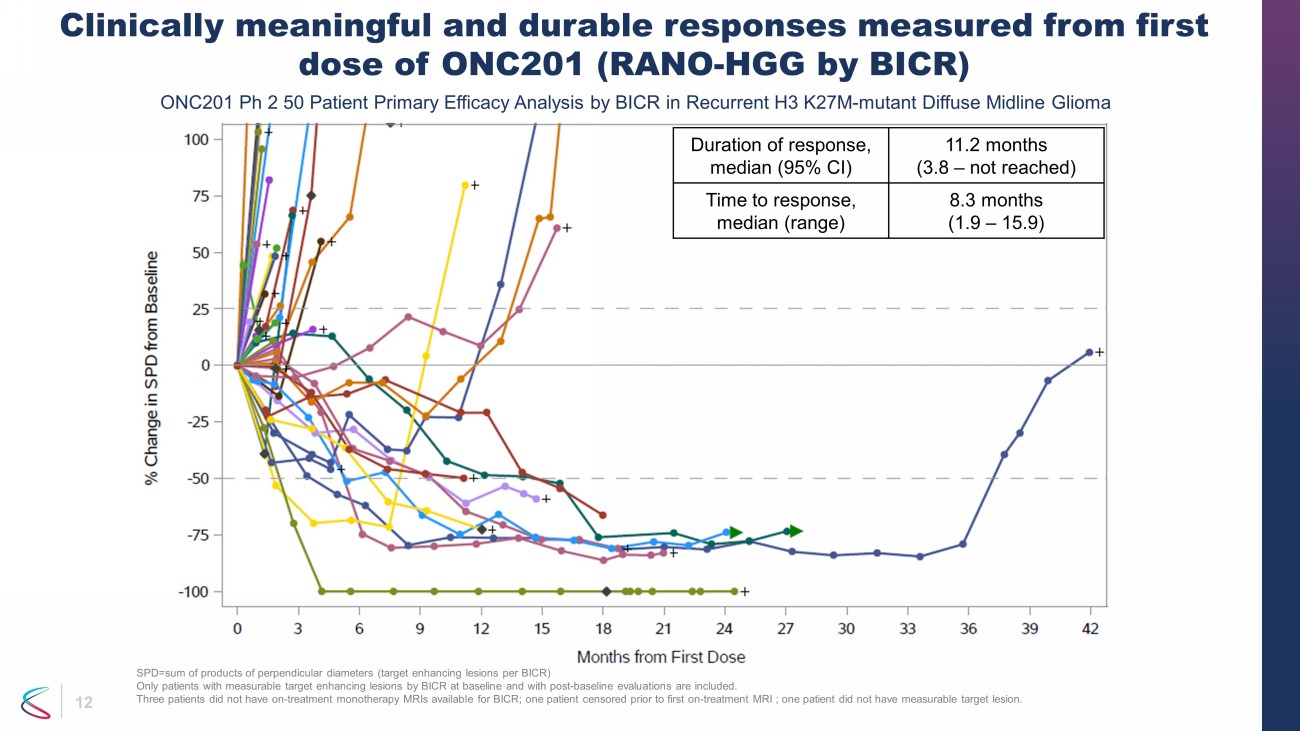
12 Clinically meaningful and durable responses measured from first dose of ONC201 (RANO - HGG by BICR) SPD=sum of products of perpendicular diameters (target enhancing lesions per BICR) Only patients with measurable target enhancing lesions by BICR at baseline and with post - baseline evaluations are included. Three patients did not have on - treatment monotherapy MRIs available for BICR; one patient censored prior to first on - treatment M RI ; one patient did not have measurable target lesion. Duration of response, median (95% CI) 11.2 months (3.8 – not reached) Time to response, median (range) 8.3 months (1.9 – 15.9) ONC201 Ph 2 50 Patient Primary Efficacy Analysis by BICR in Recurrent H3 K27M - mutant Diffuse Midline Glioma
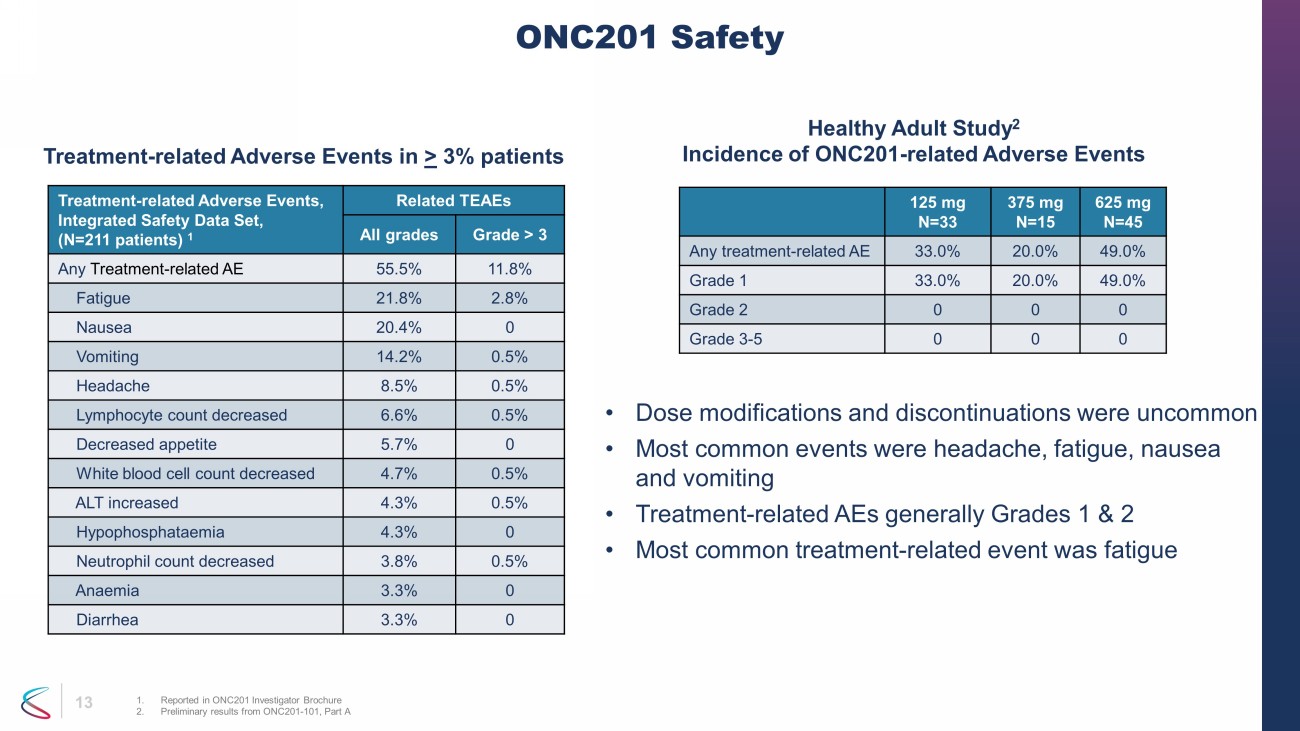
13 Treatment - related Adverse Events, Integrated Safety Data Set, (N=211 patients) 1 Related TEAEs All grades Grade > 3 Any Treatment - related AE 55.5% 11.8% Fatigue 21.8% 2.8% Nausea 20.4% 0 Vomiting 14.2% 0.5% Headache 8.5% 0.5% Lymphocyte count decreased 6.6% 0.5% Decreased appetite 5.7% 0 White blood cell count decreased 4.7% 0.5% ALT increased 4.3% 0.5% Hypophosphataemia 4.3% 0 Neutrophil count decreased 3.8% 0.5% Anaemia 3.3% 0 Diarrhea 3.3% 0 ONC201 Safety 1. Reported in ONC201 Investigator Brochure 2. Preliminary results from ONC201 - 101, Part A Healthy Adult Study 2 Incidence of ONC201 - related Adverse Events Treatment - related Adverse Events in > 3% patients • Dose modifications and discontinuations were uncommon • Most common events were headache, fatigue, nausea and vomiting • Treatment - related AEs generally Grades 1 & 2 • Most common treatment - related event was fatigue 125 mg N=33 375 mg N=15 625 mg N=45 Any treatment - related AE 33.0% 20.0% 49.0% Grade 1 33.0% 20.0% 49.0% Grade 2 0 0 0 Grade 3 - 5 0 0 0
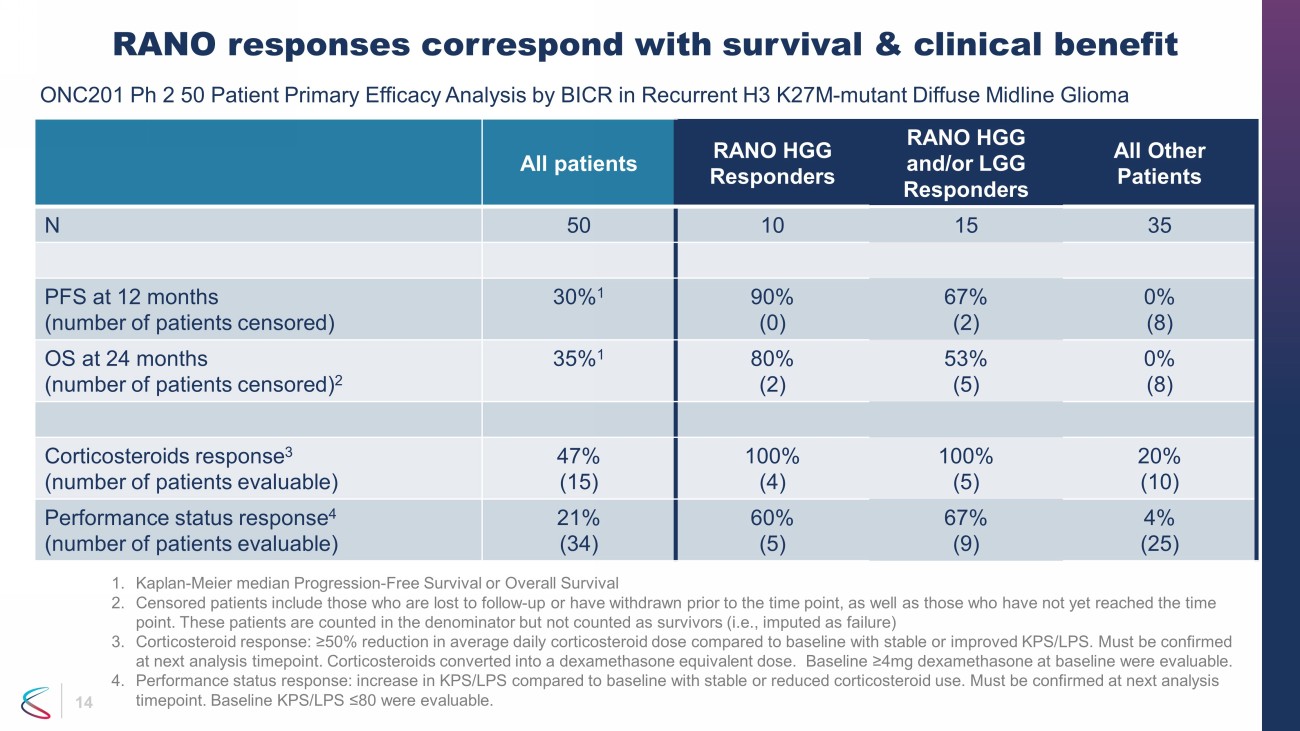
14 All patients RANO HGG Responders RANO HGG and/or LGG Responders All Other Patients N 50 10 15 35 PFS at 12 months (number of patients censored) 30% 1 90% (0) 67% (2) 0% (8) OS at 24 months (number of patients censored) 2 35% 1 80% (2) 53% (5) 0% (8) Corticosteroids response 3 (number of patients evaluable) 47% (15) 100% (4) 100% (5) 20% (10) Performance status response 4 (number of patients evaluable) 21% (34) 60% (5) 67% (9) 4% (25) RANO responses correspond with survival & clinical benefit 1. Kaplan - Meier median Progression - Free Survival or Overall Survival 2. Censored patients include those who are lost to follow - up or have withdrawn prior to the time point, as well as those who have n ot yet reached the time point. These patients are counted in the denominator but not counted as survivors (i.e., imputed as failure) 3. Corticosteroid response: ≥50% reduction in average daily corticosteroid dose compared to baseline with stable or improved KPS /LP S. Must be confirmed at next analysis timepoint. Corticosteroids converted into a dexamethasone equivalent dose. Baseline ≥4mg dexamethasone at b ase line were evaluable. 4. Performance status response: increase in KPS/LPS compared to baseline with stable or reduced corticosteroid use. Must be conf irm ed at next analysis timepoint. Baseline KPS/LPS ≤80 were evaluable. ONC201 Ph 2 50 Patient Primary Efficacy Analysis by BICR in Recurrent H3 K27M - mutant Diffuse Midline Glioma
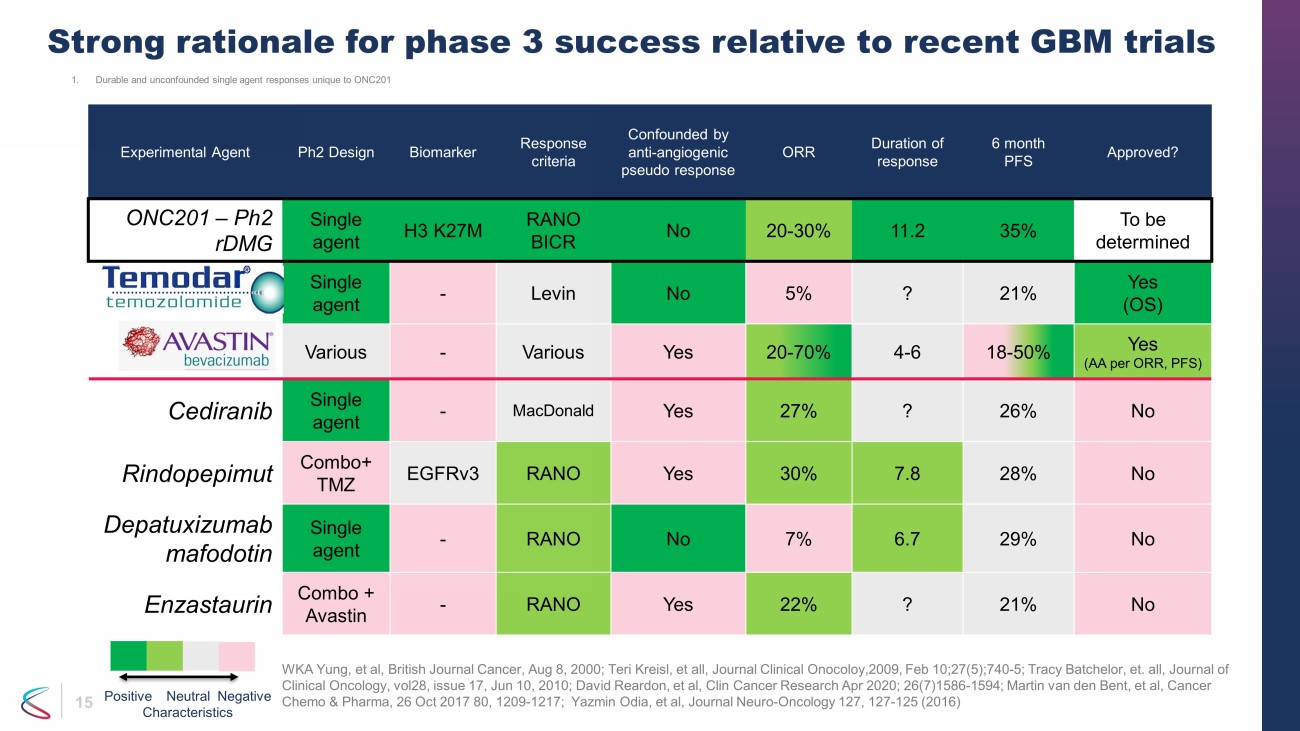
15 Experimental Agent Ph2 Design Biomarker Response criteria Confounded by anti - angiogenic pseudo response ORR Duration of response 6 month PFS Approved? ONC201 – Ph2 rDMG Single agent H3 K27M RANO BICR No 20 - 30% 11.2 35% To be determined Temozolomide Single agent - Levin No 5% ? 21% Yes (OS) Bevacizumab Various - Various Yes 20 - 70% 4 - 6 18 - 50% Yes (AA per ORR, PFS) Cediranib Single agent - MacDonald Yes 27% ? 26% No Rindopepimut Combo+ TMZ EGFRv3 RANO Yes 30% 7.8 28% No Depatuxizumab mafodotin Single agent - RANO No 7% 6.7 29% No Enzastaurin Combo + Avastin - RANO Yes 22% ? 21% No Strong rationale for phase 3 success relative to recent GBM trials 1. Durable and unconfounded single agent responses unique to ONC201 Positive Neutral Negative Characteristics r WKA Yung, et al, British Journal Cancer, Aug 8, 2000; Teri Kreisl , et all, Journal Clinical Onocoloy,2009, Feb 10;27(5);740 - 5; Tracy Batchelor, et. all, Journal of Clinical Oncology, vol28, issue 17, Jun 10, 2010; David Reardon, et al, Clin Cancer Research Apr 2020; 26(7)1586 - 1594; Martin va n den Bent, et al, Cancer Chemo & Pharma, 26 Oct 2017 80, 1209 - 1217; Yazmin Odia, et al, Journal Neuro - Oncology 127, 127 - 125 (2016)
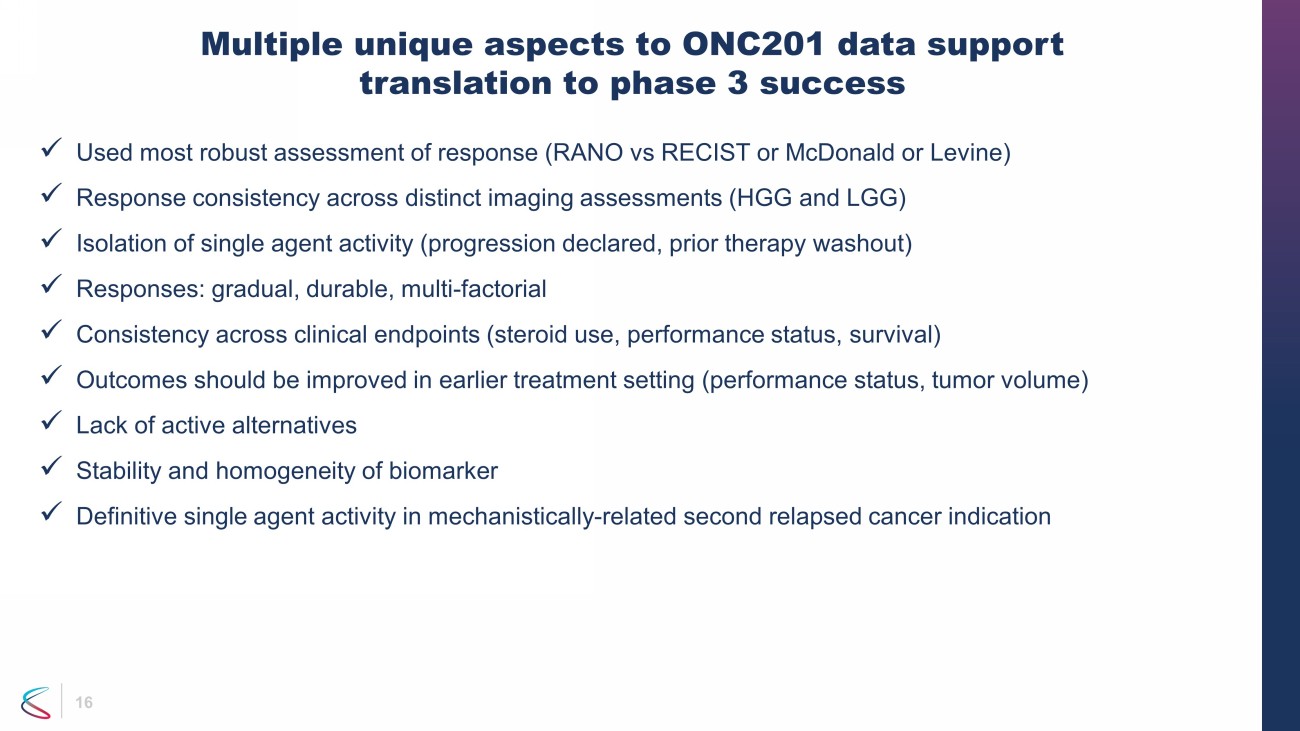
16 x Used most robust assessment of response (RANO vs RECIST or McDonald or Levine) x Response consistency across distinct imaging assessments (HGG and LGG) x Isolation of single agent activity (progression declared, prior therapy washout) x Responses: gradual, durable , multi - factorial x Consistency across clinical endpoints (steroid use, performance status, survival) x Outcomes should be improved in earlier treatment setting (performance status, tumor volume) x Lack of active alternatives x Stability and homogeneity of biomarker x Definitive single agent activity in mechanistically - related second relapsed cancer indication Multiple unique aspects to ONC201 data support translation to phase 3 success
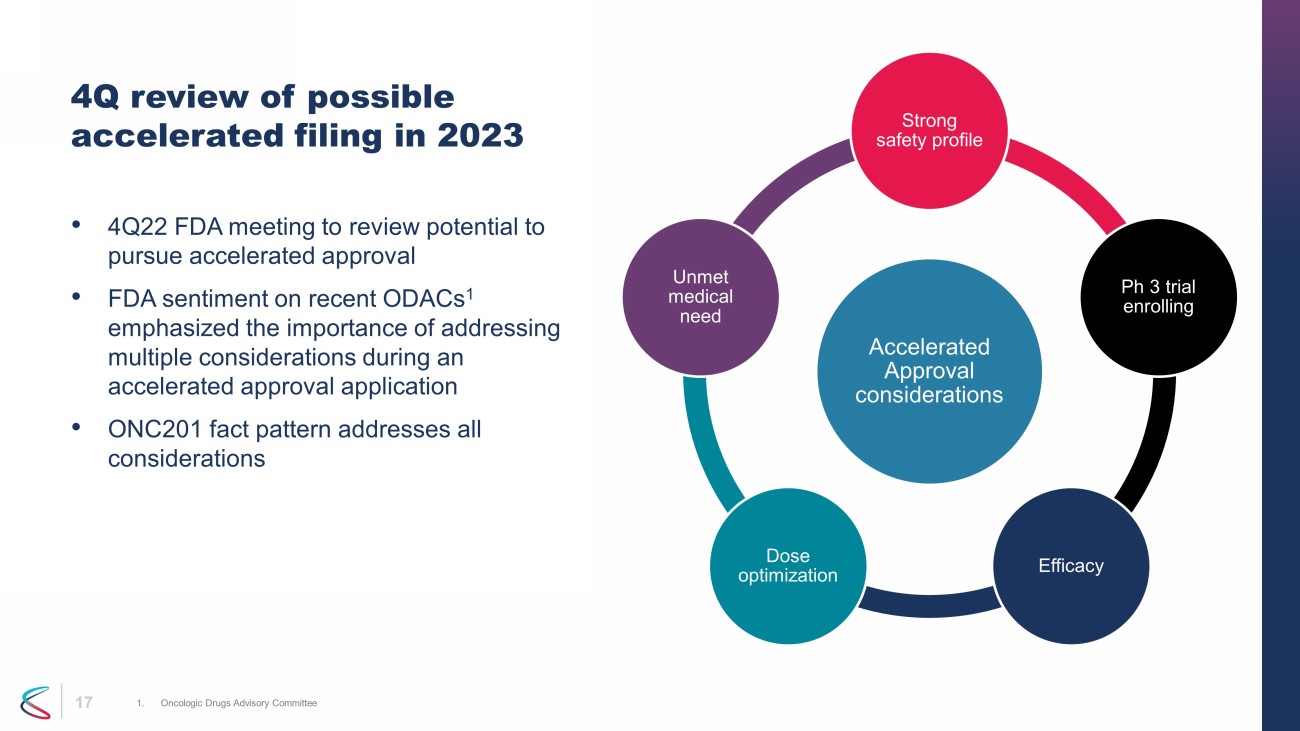
17 17 1. Oncologic Drugs Advisory Committee 4Q review of possible accelerated filing in 2023 Accelerated Approval considerations Strong safety profile Ph 3 trial enrolling Efficacy Dose optimization Unmet medical need • 4Q22 FDA meeting to review potential to pursue accelerated approval • FDA sentiment on recent ODACs 1 emphasized the importance of addressing multiple considerations during an accelerated approval application • ONC201 fact pattern addresses all considerations
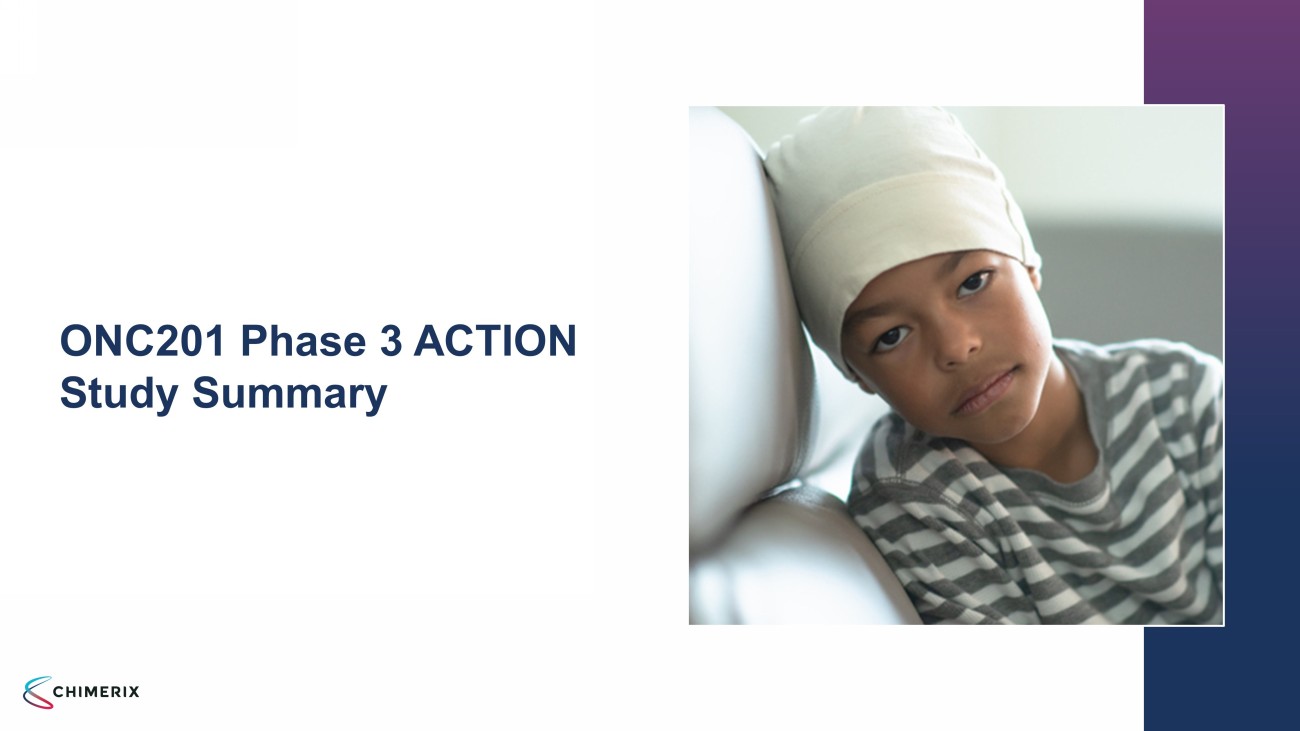
ONC201 Phase 3 ACTION Study Summary
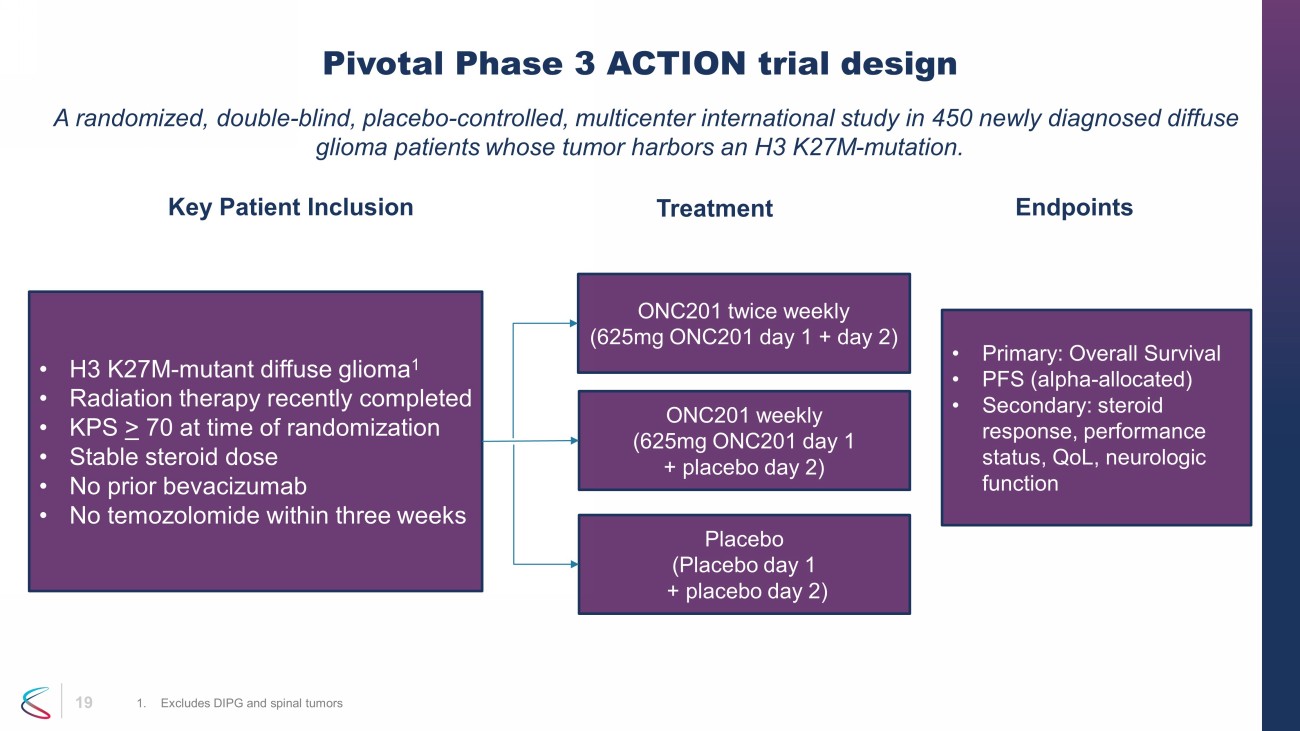
19 A randomized, double - blind, placebo - controlled, multicenter international study in 450 newly diagnosed diffuse glioma patients whose tumor harbors an H3 K27M - mutation. Pivotal Phase 3 ACTION trial design 1. Excludes DIPG and spinal tumors • H3 K27M - mutant diffuse glioma 1 • Radiation therapy recently completed • KPS > 70 at time of randomization • Stable steroid dose • No prior bevacizumab • No temozolomide within three weeks ONC201 twice weekly (625mg ONC201 day 1 + day 2) ONC201 weekly (625mg ONC201 day 1 + placebo day 2) Placebo (Placebo day 1 + placebo day 2) • Primary: Overall Survival • PFS (alpha - allocated) • Secondary: steroid response, performance status, QoL, neurologic function Key Patient Inclusion Endpoints Treatment
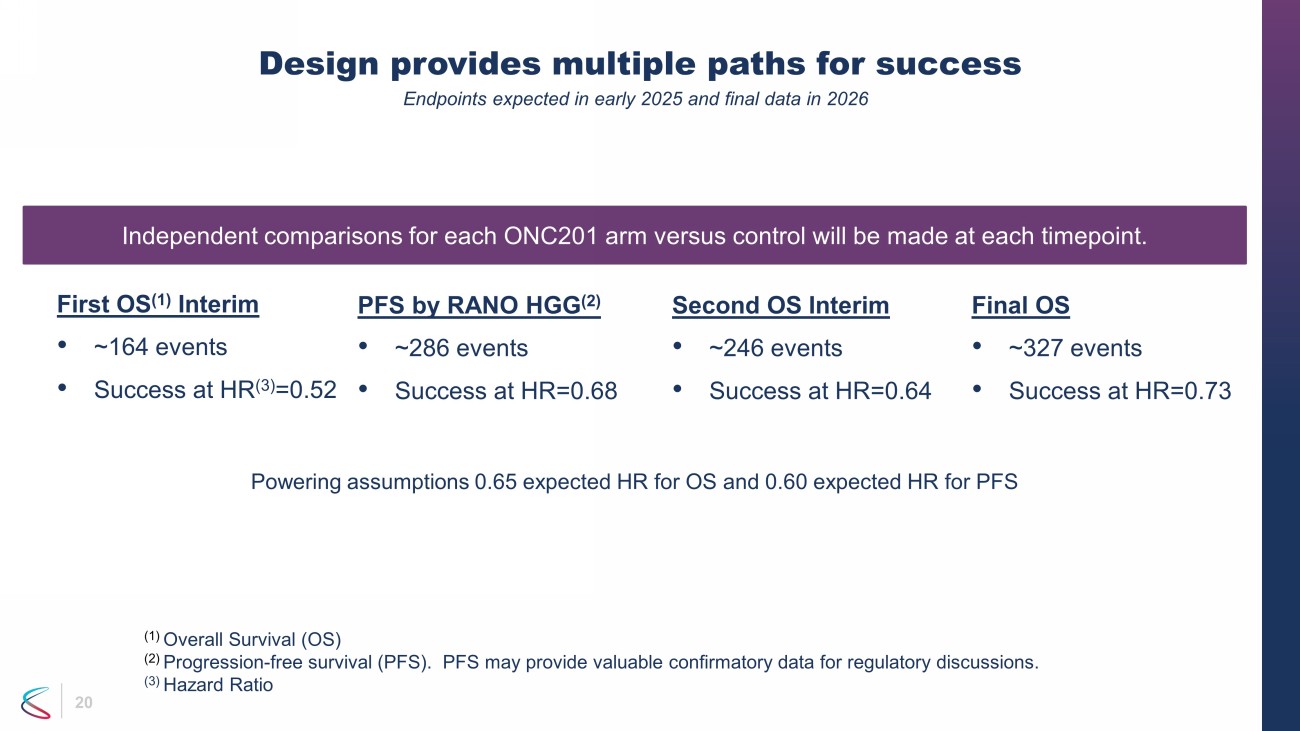
20 Design provides multiple paths for success Endpoints expected in early 2025 and final data in 2026 Second OS Interim • ~246 events • Success at HR=0.64 Final OS • ~327 events • Success at HR=0.73 PFS by RANO HGG (2) • ~286 events • Success at HR=0.68 (1) Overall Survival (OS) (2) Progression - free survival (PFS). PFS may provide valuable confirmatory data for regulatory discussions. (3) Hazard Ratio Independent comparisons for each ONC201 arm versus control will be made at each timepoint. Powering assumptions 0.65 expected HR for OS and 0.60 expected HR for PFS First OS (1) Interim • ~164 events • Success at HR (3) =0.52
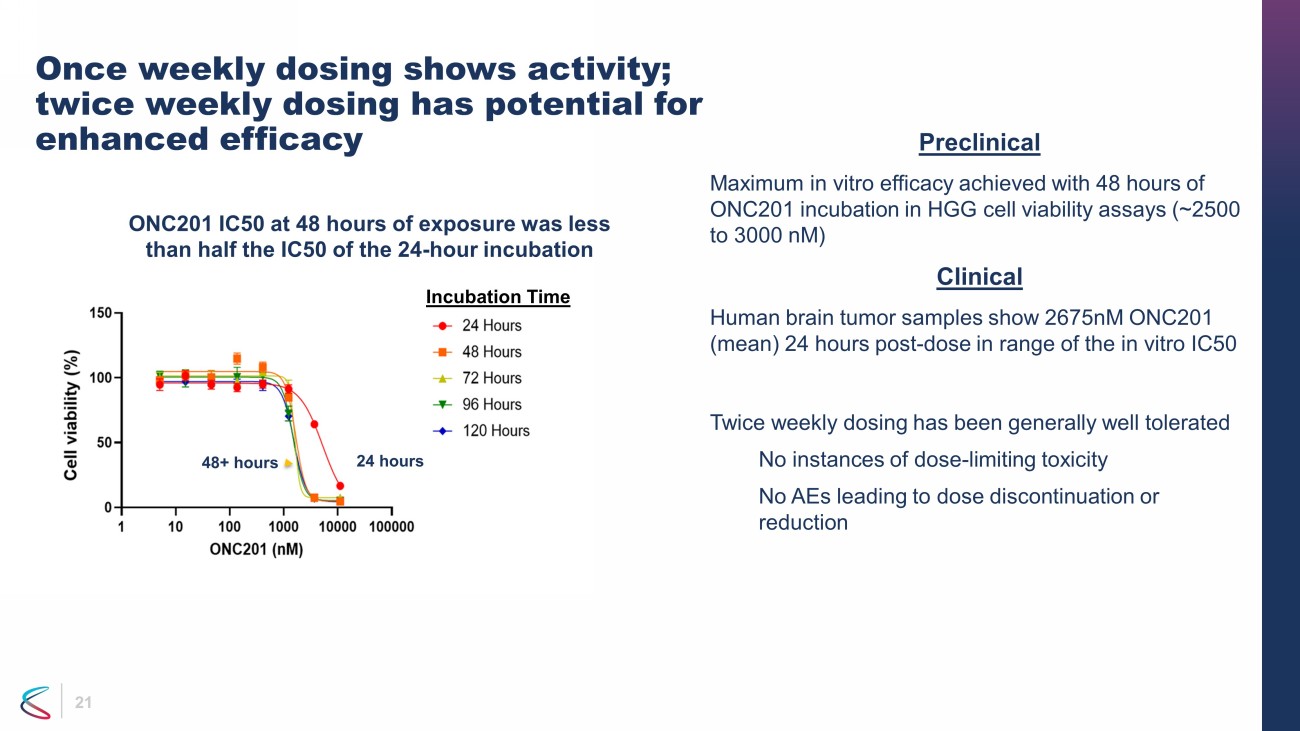
21 21 Once weekly dosing shows activity; twice weekly dosing has potential for enhanced efficacy Preclinical Maximum in vitro efficacy achieved with 48 hours of ONC201 incubation in HGG cell viability assays (~2500 to 3000 nM ) Clinical Human brain tumor samples show 2675nM ONC201 (mean) 24 hours post - dose in range of the in vitro IC50 Twice weekly dosing has been generally well tolerated No instances of dose - limiting toxicity No AEs leading to dose discontinuation or reduction 24 hours 48+ hours Incubation Time ONC201 IC50 at 48 hours of exposure was less than half the IC50 of the 24 - hour incubation
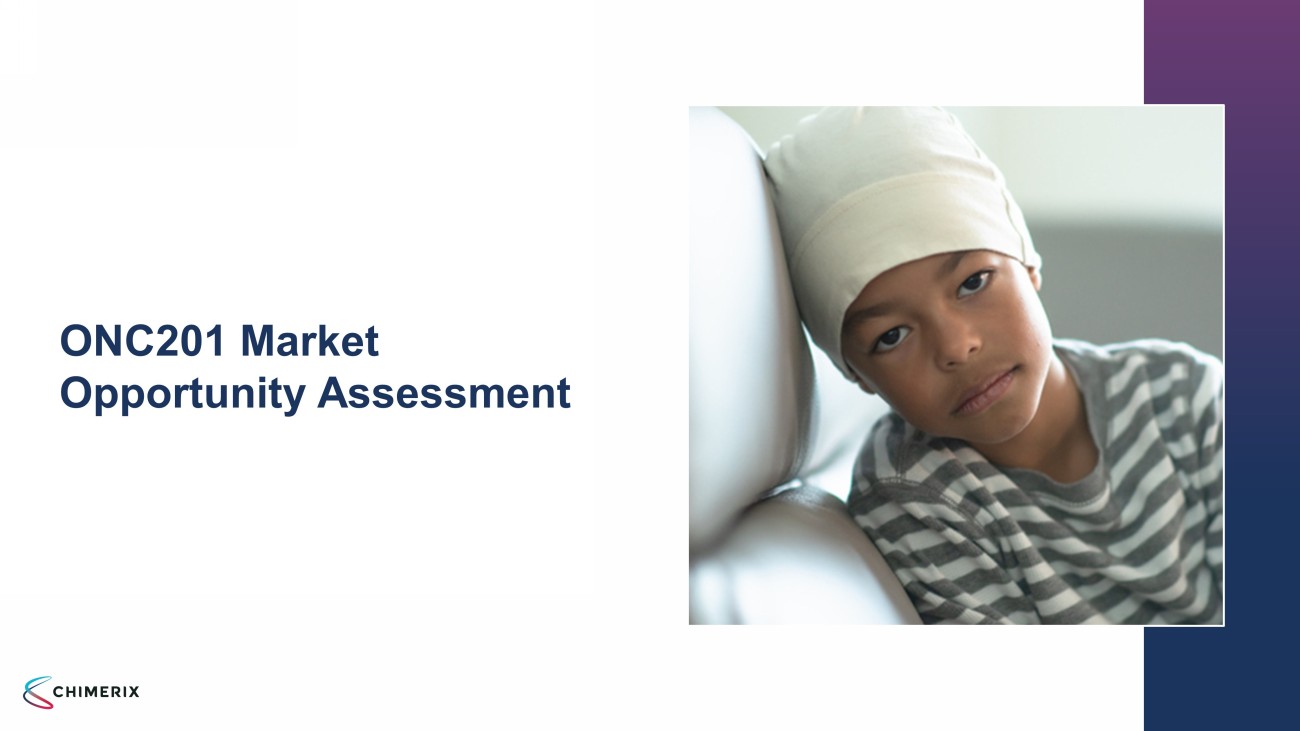
ONC201 Market Opportunity Assessment
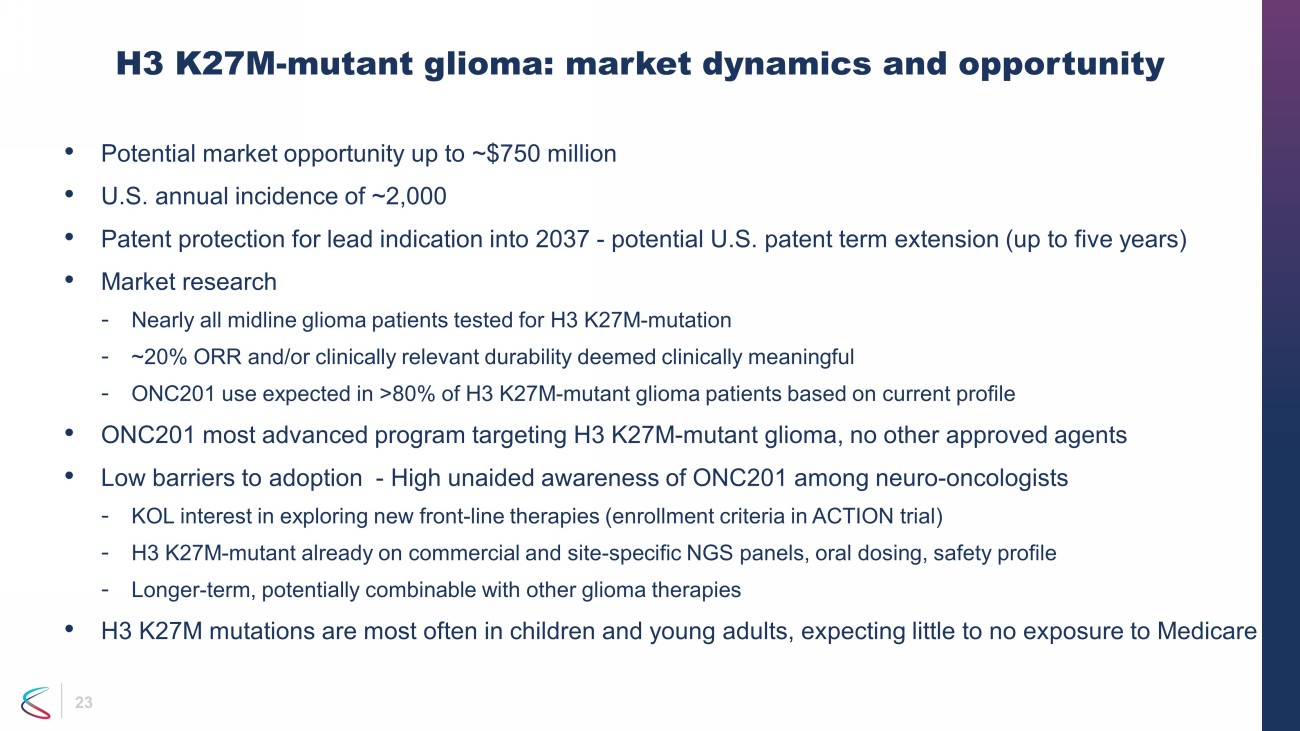
23 • Potential market opportunity up to ~$750 million • U.S. annual incidence of ~2,000 • Patent protection for lead indication into 2037 - potential U.S. patent term extension (up to five years) • Market research - Nearly all midline glioma patients tested for H3 K27M - mutation - ~20% ORR and/or clinically relevant durability deemed clinically meaningful - ONC201 use expected in >80% of H3 K27M - mutant glioma patients based on current profile • ONC201 most advanced program targeting H3 K27M - mutant glioma, no other approved agents • Low barriers to adoption - High unaided awareness of ONC201 among neuro - oncologists - KOL interest in exploring new front - line therapies (enrollment criteria in ACTION trial) - H3 K27M - mutant already on commercial and site - specific NGS panels, oral dosing, safety profile - Longer - term, potentially combinable with other glioma therapies • H3 K27M mutations are most often in children and young adults, expecting little to no exposure to Medicare H3 K27M - mutant glioma: market dynamics and opportunity
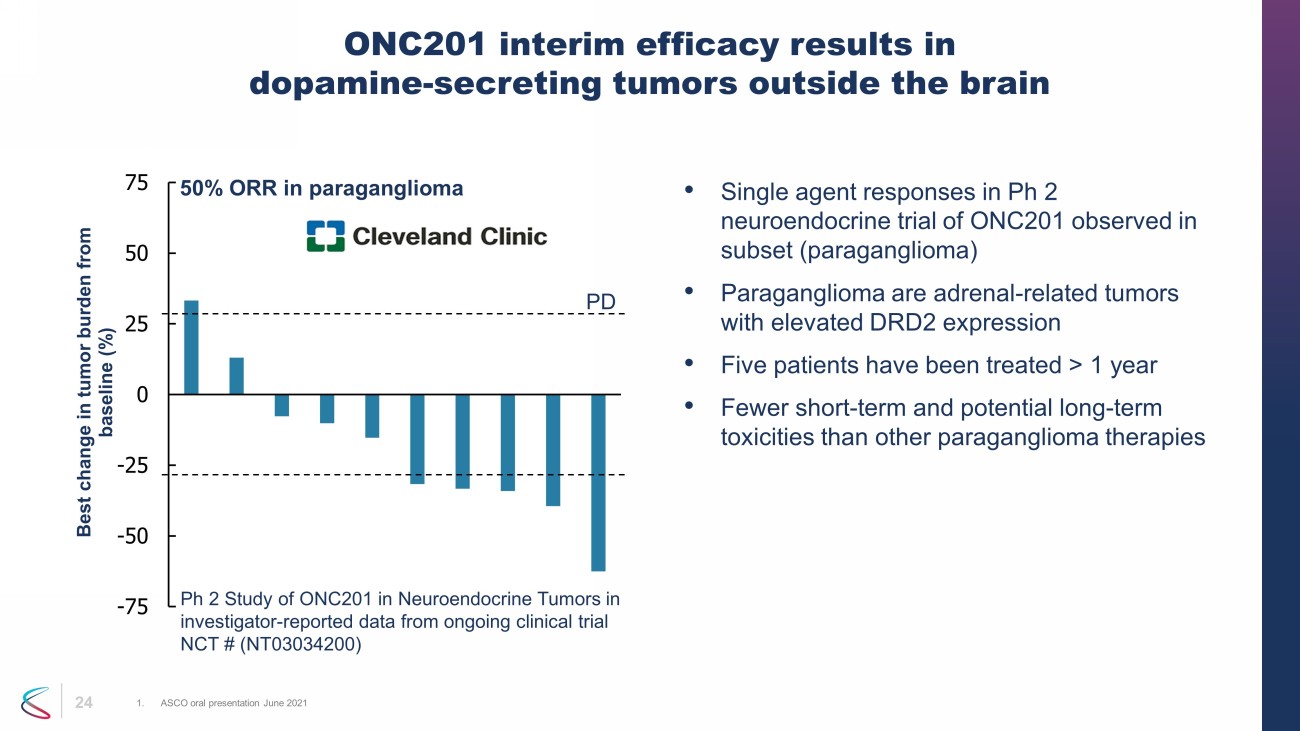
24 • Single agent responses in Ph 2 neuroendocrine trial of ONC201 observed in subset (paraganglioma) • Paraganglioma are adrenal - related tumors with elevated DRD2 expression • Five patients have been treated > 1 year • Fewer short - term and potential long - term toxicities than other paraganglioma therapies ONC201 interim efficacy results in dopamine - secreting tumors outside the brain 1. ASCO oral presentation June 2021 -75 -50 -25 0 25 50 75 Best change in tumor burden from baseline (%) 50% ORR in paraganglioma PD Ph 2 Study of ONC201 in Neuroendocrine Tumors in investigator - reported data from ongoing clinical trial NCT # (NT03034200)
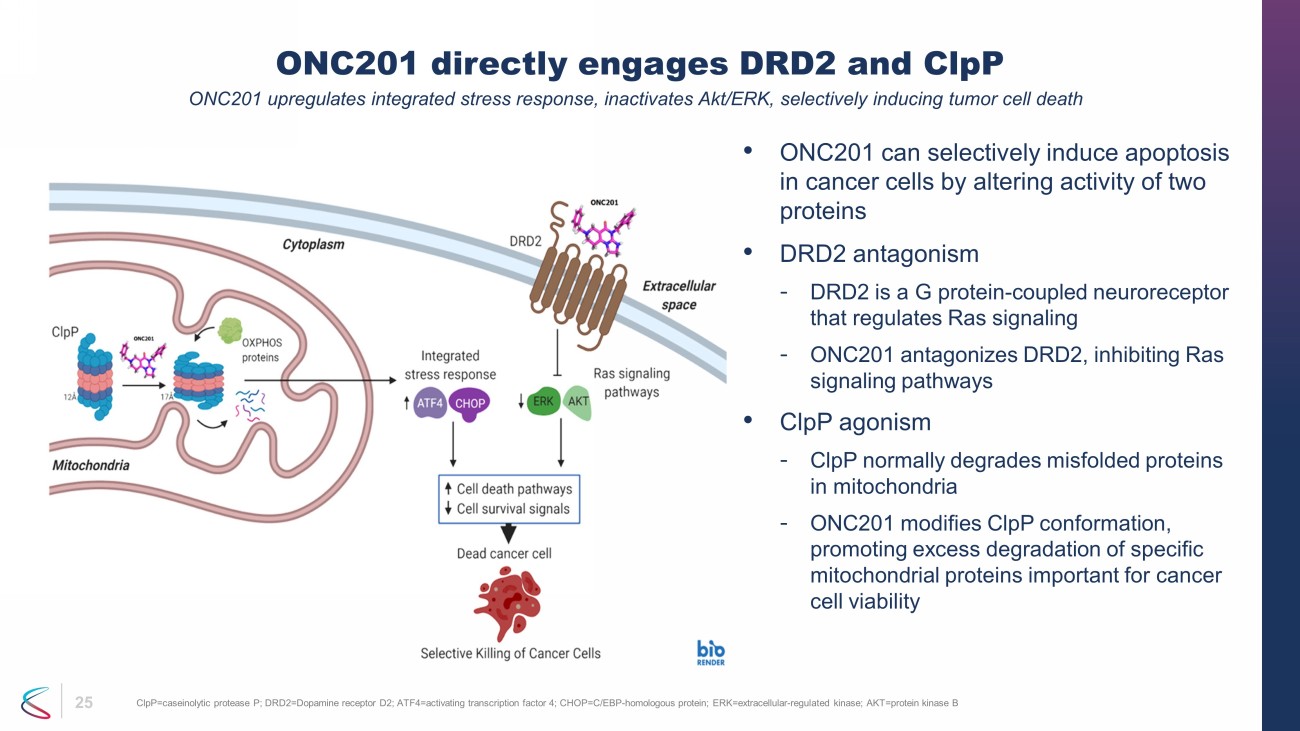
25 • ONC201 can selectively induce apoptosis in cancer cells by altering activity of two proteins • DRD2 antagonism - DRD2 is a G protein - coupled neuroreceptor that regulates Ras signaling - ONC201 antagonizes DRD2, inhibiting Ras signaling pathways • ClpP agonism - ClpP normally degrades misfolded proteins in mitochondria - ONC201 modifies ClpP conformation, promoting excess degradation of specific mitochondrial proteins important for cancer cell viability ONC201 directly engages DRD2 and ClpP ONC201 upregulates integrated stress response, inactivates Akt/ERK, selectively inducing tumor cell death ClpP =caseinolytic protease P; DRD2=Dopamine receptor D2; ATF4=activating transcription factor 4; CHOP=C/EBP - homologous protein; ERK= extracellular - regulated kinase; AKT=protein kinase B
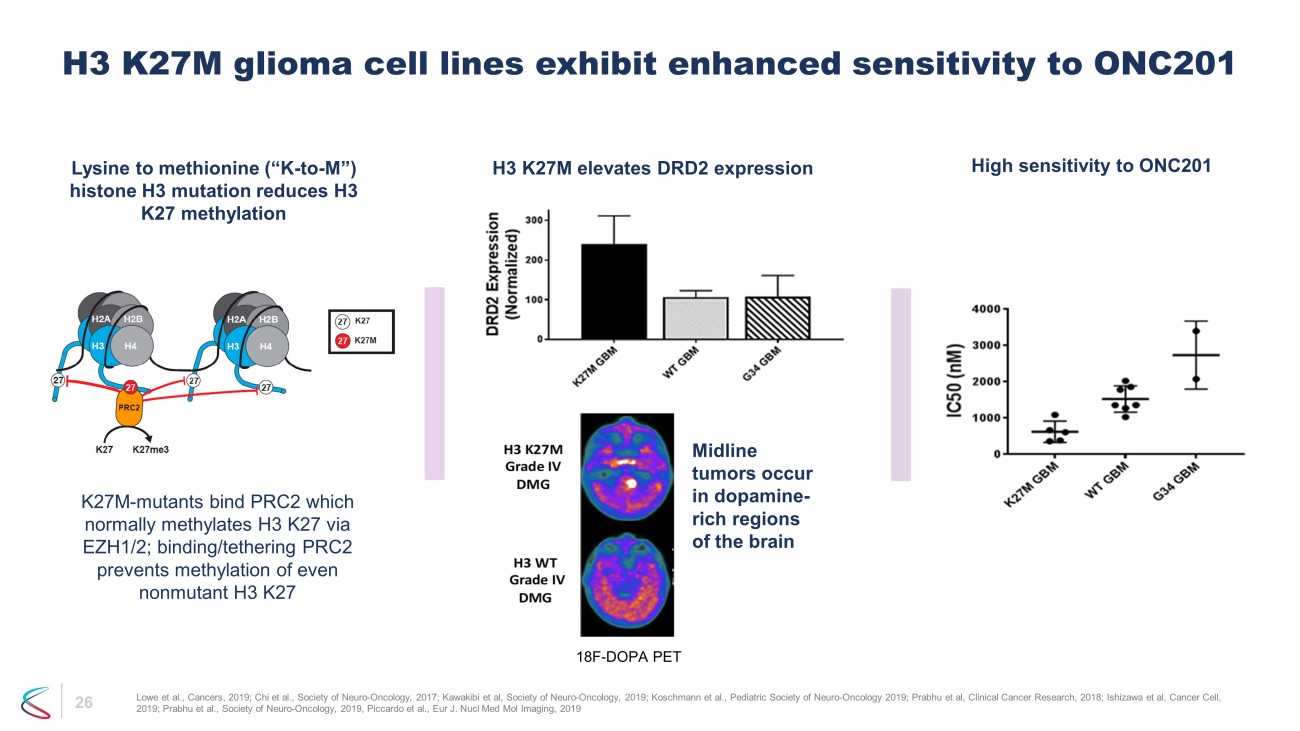
26 H3 K27M glioma cell lines exhibit enhanced sensitivity to ONC201 Lowe et al., Cancers, 2019; Chi et al., Society of Neuro - Oncology, 2017; Kawakibi et al, Society of Neuro - Oncology, 2019; Koschmann et al., Pediatric Society of Neuro - Oncology 2019; Prabhu et al, Clinical Canc er Research, 2018; Ishizawa et al, Cancer Cell, 2019; Prabhu et al., Society of Neuro - Oncology, 2019, Piccardo et al., Eur J. Nucl Med Mol Imaging, 2019 High sensitivity to ONC201 Lysine to methionine (“K - to - M”) histone H3 mutation reduces H3 K27 methylation H3 K27M elevates DRD2 expression K27M - mutants bind PRC2 which normally methylates H3 K27 via EZH1/2; binding/tethering PRC2 prevents methylation of even nonmutant H3 K27 Midline tumors occur in dopamine - rich regions of the brain 18F - DOPA PET
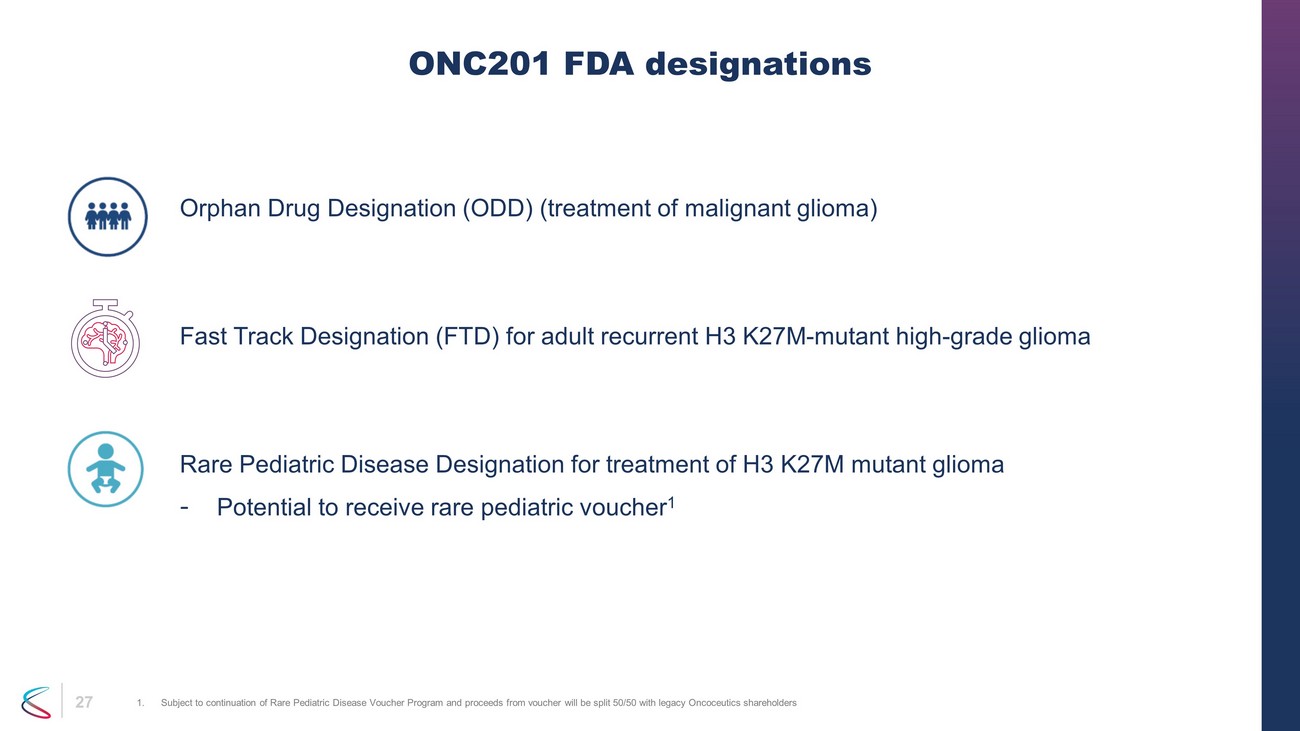
1 ONC201 FDA designations 1. Subject to continuation of Rare Pediatric Disease Voucher Program and proceeds from voucher will be split 50/50 with legacy O nco ceutics shareholders Orphan Drug Designation (ODD) (treatment of malignant glioma) Fast Track Designation (FTD) for adult recurrent H3 K27M - mutant high - grade glioma Rare Pediatric Disease Designation for treatment of H3 K27M mutant glioma - Potential to receive rare pediatric voucher 1
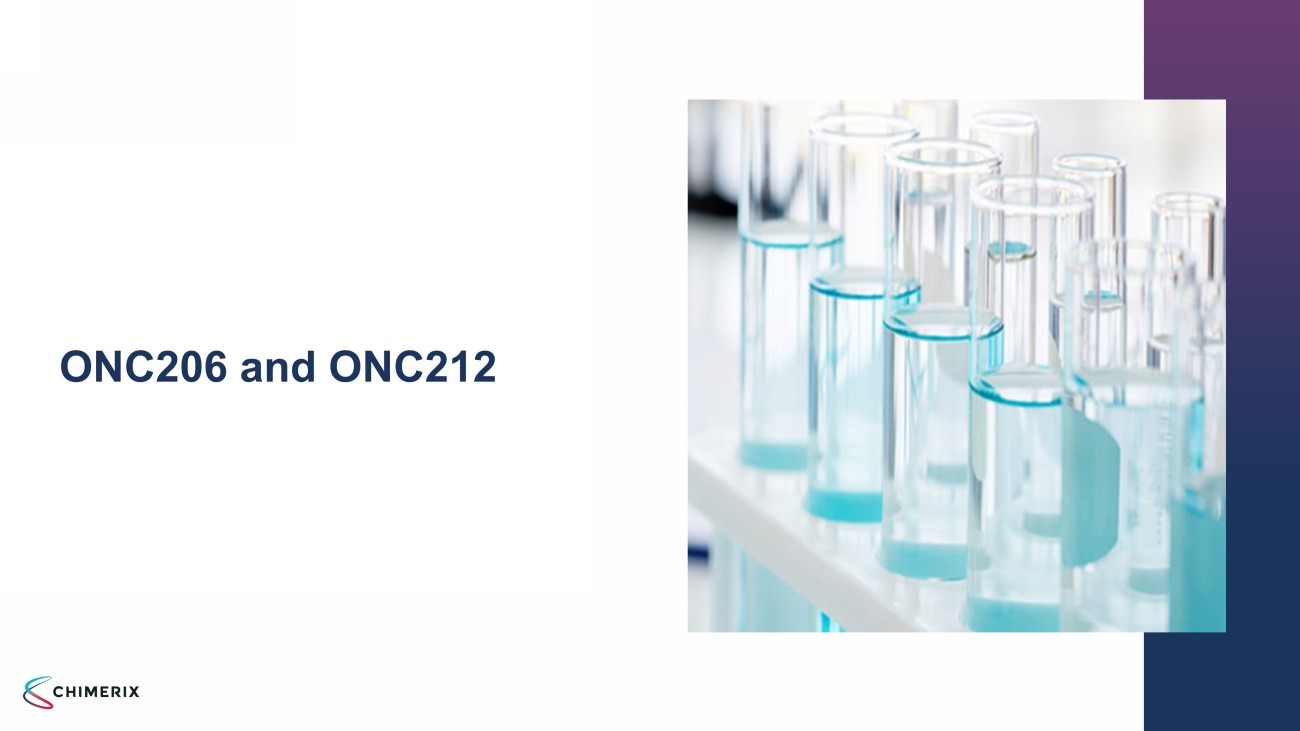
ONC206 and ONC212

29 • Focus in current clinical trials on recurrent central nervous system (CNS) cancers • Efficacy in preclinical models of central nervous system and other tumors • Enrolling 2 dose escalation clinical trials for adult and pediatric CNS tumor patients • In vivo exploration of alternative lead indications ONC206: potentially differentiated DRD2 antagonist + ClpP agonist ONC206 Efficacy in Tumor Xenografts 1 1. Wen Hu et al, August 27, 2020; Cancers
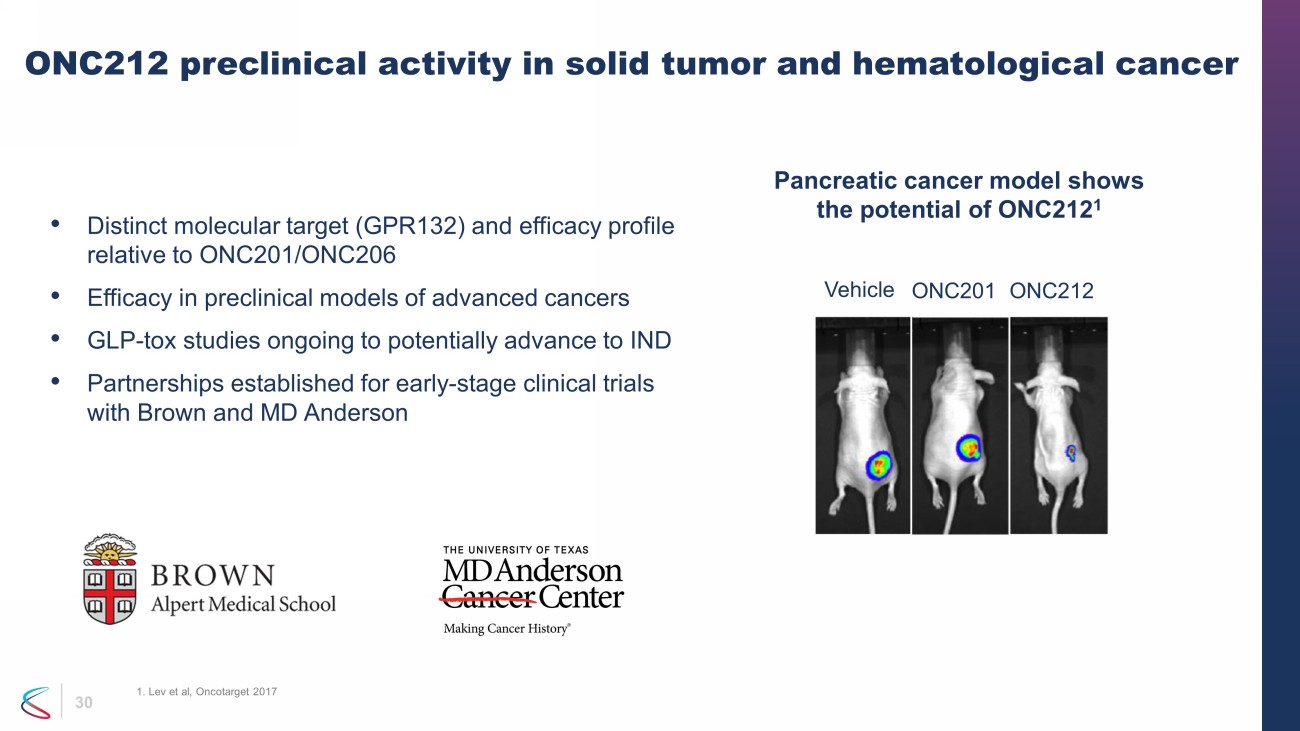
30 ONC212 preclinical activity in solid tumor and hematological cancer • Distinct molecular target (GPR132) and efficacy profile relative to ONC201/ONC206 • Efficacy in preclinical models of advanced cancers • GLP - tox studies ongoing to potentially advance to IND • Partnerships established for early - stage clinical trials with Brown and MD Anderson Pancreatic cancer model shows the potential of ONC212 1 1. Lev et al, Oncotarget 2017 Vehicle ONC201 ONC212
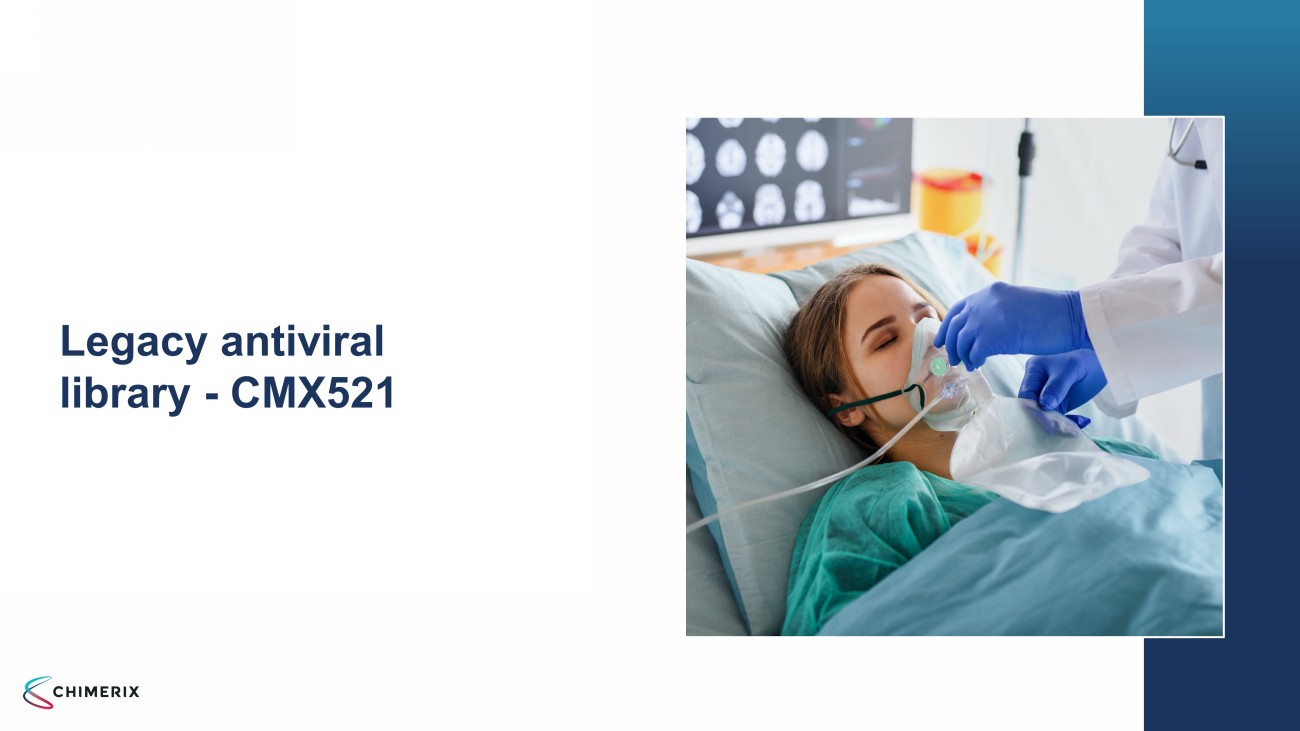
Legacy antiviral library - CMX521
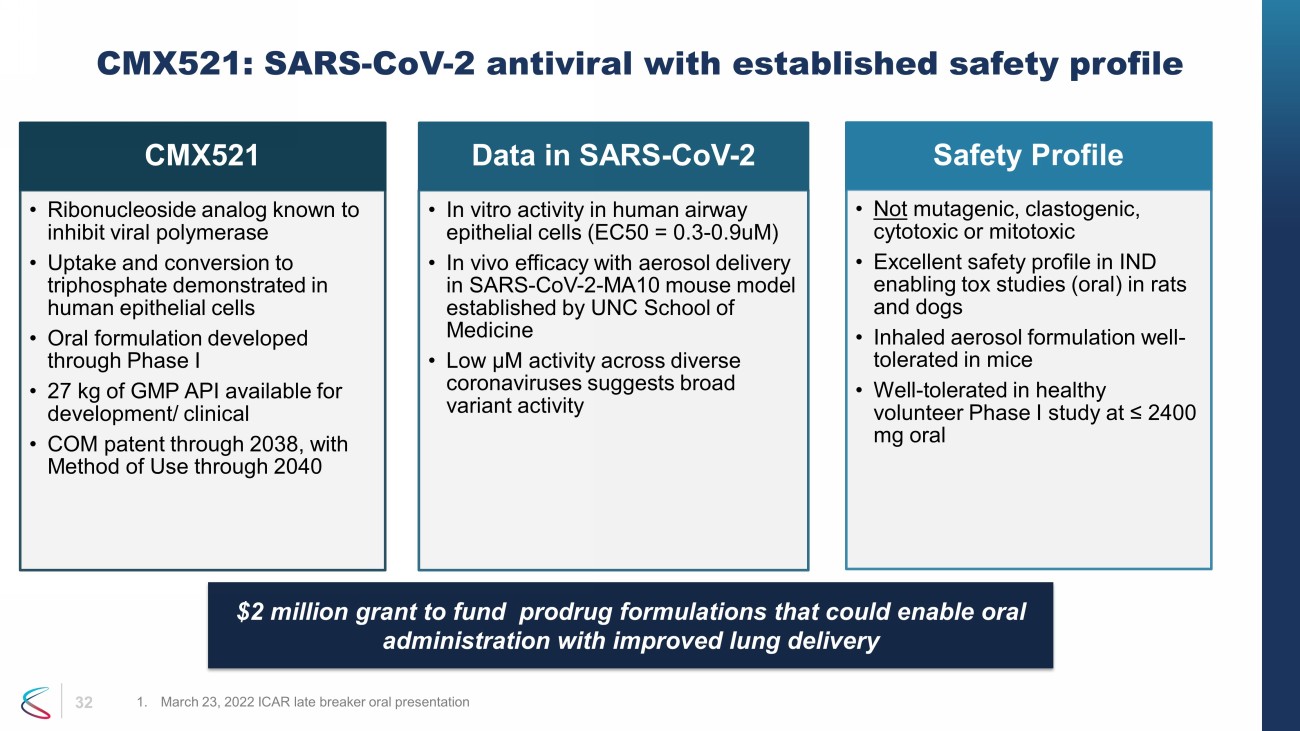
32 CMX521 • Ribonucleoside analog known to inhibit viral polymerase • Uptake and conversion to triphosphate demonstrated in human epithelial cells • Oral formulation developed through Phase I • 27 kg of GMP API available for development/ clinical • COM patent through 2038, with Method of Use through 2040 Data in SARS - CoV - 2 • In vitro activity in human airway epithelial cells (EC50 = 0.3 - 0.9uM) • In vivo efficacy with aerosol delivery in SARS - CoV - 2 - MA10 mouse model established by UNC School of Medicine • Low µM activity across diverse coronaviruses suggests broad variant activity Safety Profile • Not mutagenic, clastogenic, cytotoxic or mitotoxic • Excellent safety profile in IND enabling tox studies (oral) in rats and dogs • Inhaled aerosol formulation well - tolerated in mice • Well - tolerated in healthy volunteer Phase I study at ≤ 2400 mg oral CMX521: SARS - CoV - 2 antiviral with established safety profile 1. March 23, 2022 ICAR late breaker oral presentation $2 million grant to fund prodrug formulations that could enable oral administration with improved lung delivery
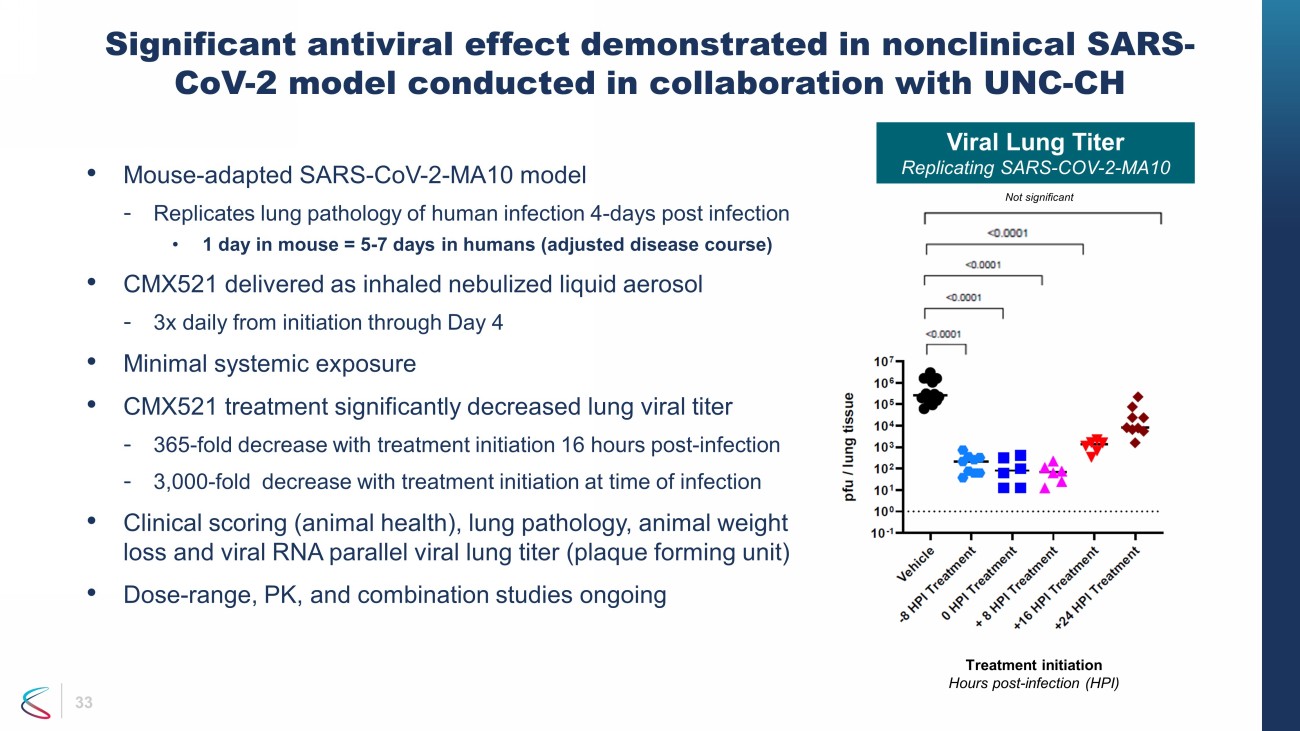
33 • Mouse - adapted SARS - CoV - 2 - MA10 model - Replicates lung pathology of human infection 4 - days post infection • 1 day in mouse = 5 - 7 days in humans (adjusted disease course) • CMX521 delivered as inhaled nebulized liquid aerosol - 3x daily from initiation through Day 4 • Minimal systemic exposure • CMX521 treatment significantly decreased lung viral titer - 365 - fold decrease with treatment initiation 16 hours post - infection - 3,000 - fold decrease with treatment initiation at time of infection • Clinical scoring (animal health), lung pathology, animal weight loss and viral RNA parallel viral lung titer (plaque forming unit) • Dose - range, PK, and combination studies ongoing Significant antiviral effect demonstrated in nonclinical SARS - CoV - 2 model conducted in collaboration with UNC - CH Not significant Viral Lung Titer Replicating SARS - COV - 2 - MA10 Treatment initiation Hours post - infection (HPI)
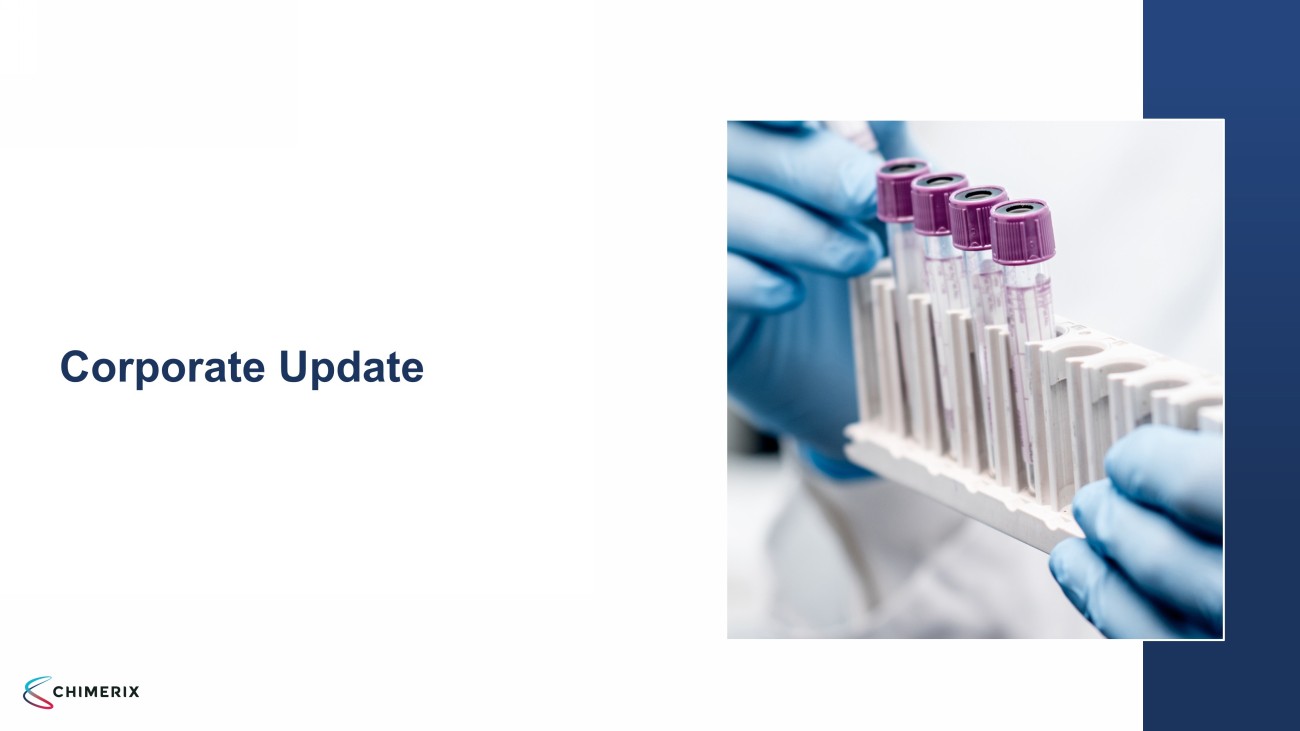
Corporate Update
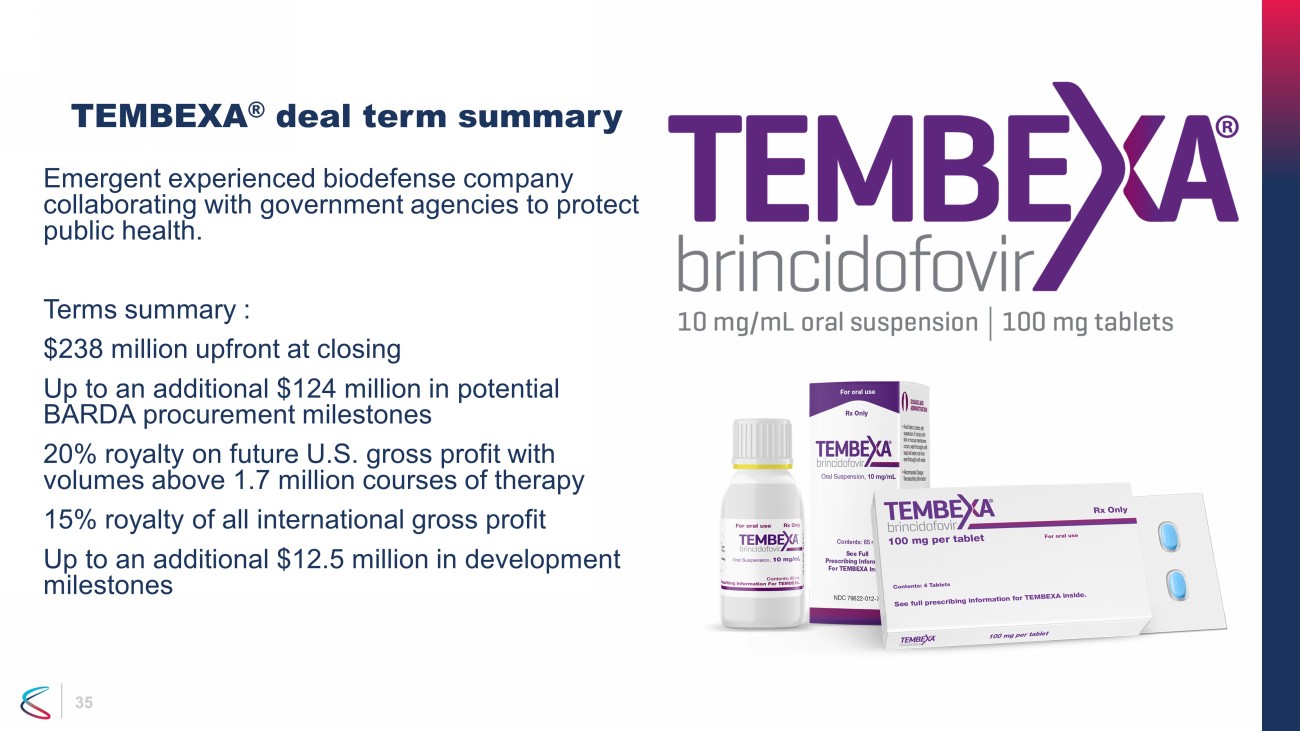
35 35 TEMBEXA ® deal term summary Emergent experienced biodefense company collaborating with government agencies to protect public health. Terms summary : $238 million upfront at closing Up to an additional $124 million in potential BARDA procurement milestones 20% royalty on future U.S. gross profit with volumes above 1.7 million courses of therapy 15% royalty of all international gross profit Up to an additional $12.5 million in development milestones
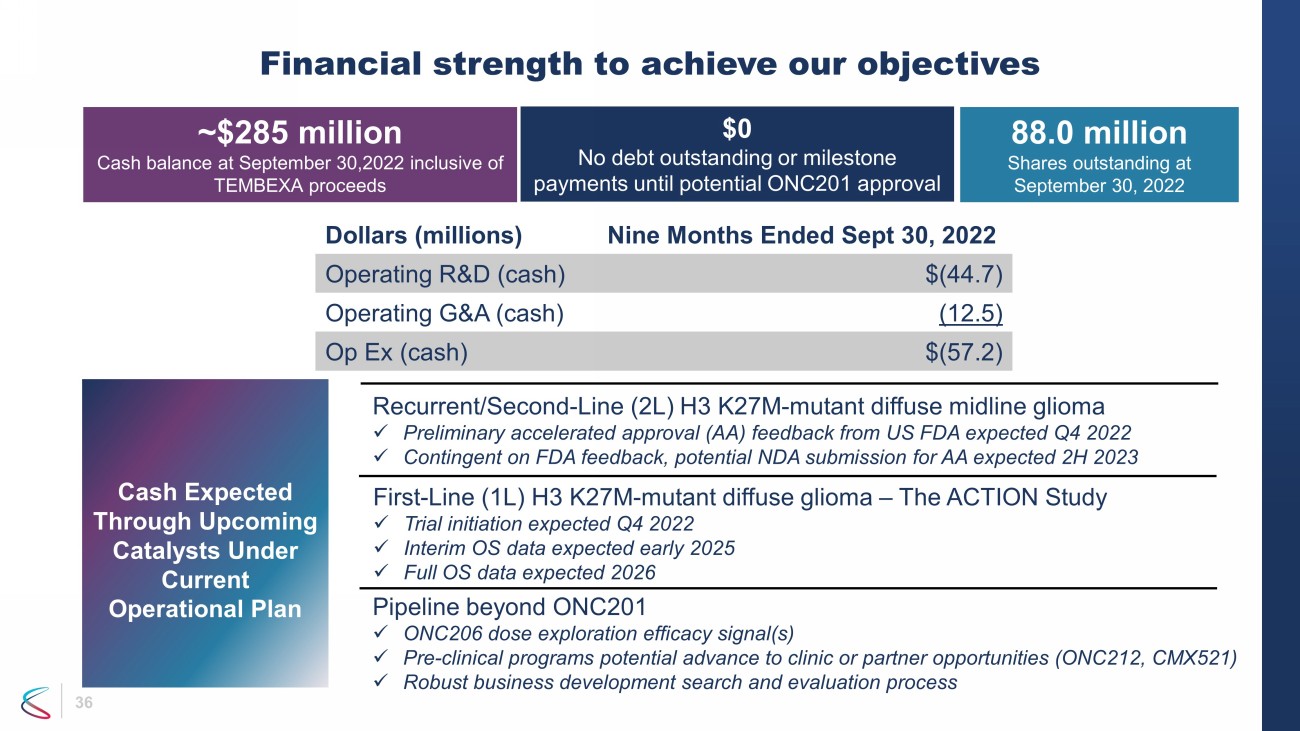
36 Financial strength to achieve our objectives Dollars (millions) Nine Months Ended Sept 30, 2022 Operating R&D (cash) $(44.7) Operating G&A (cash) (12.5) Op Ex (cash) $(57.2) Cash Expected Through Upcoming Catalysts Under Current Operational Plan Recurrent/Second - Line (2L) H3 K27M - mutant diffuse midline glioma x Preliminary accelerated approval (AA) feedback from US FDA expected Q4 2022 x Contingent on FDA feedback, potential NDA submission for AA expected 2H 2023 First - Line (1L) H3 K27M - mutant diffuse glioma – The ACTION Study x Trial initiation expected Q4 2022 x Interim OS data expected early 2025 x Full OS data expected 2026 Pipeline beyond ONC201 x ONC206 dose exploration efficacy signal(s) x Pre - clinical programs potential advance to clinic or partner opportunities (ONC212, CMX521) x Robust business development search and evaluation process ~$285 million Cash balance at September 30,2022 inclusive of TEMBEXA proceeds $0 No debt outstanding or milestone payments until potential ONC201 approval 88.0 million Shares outstanding at September 30, 2022
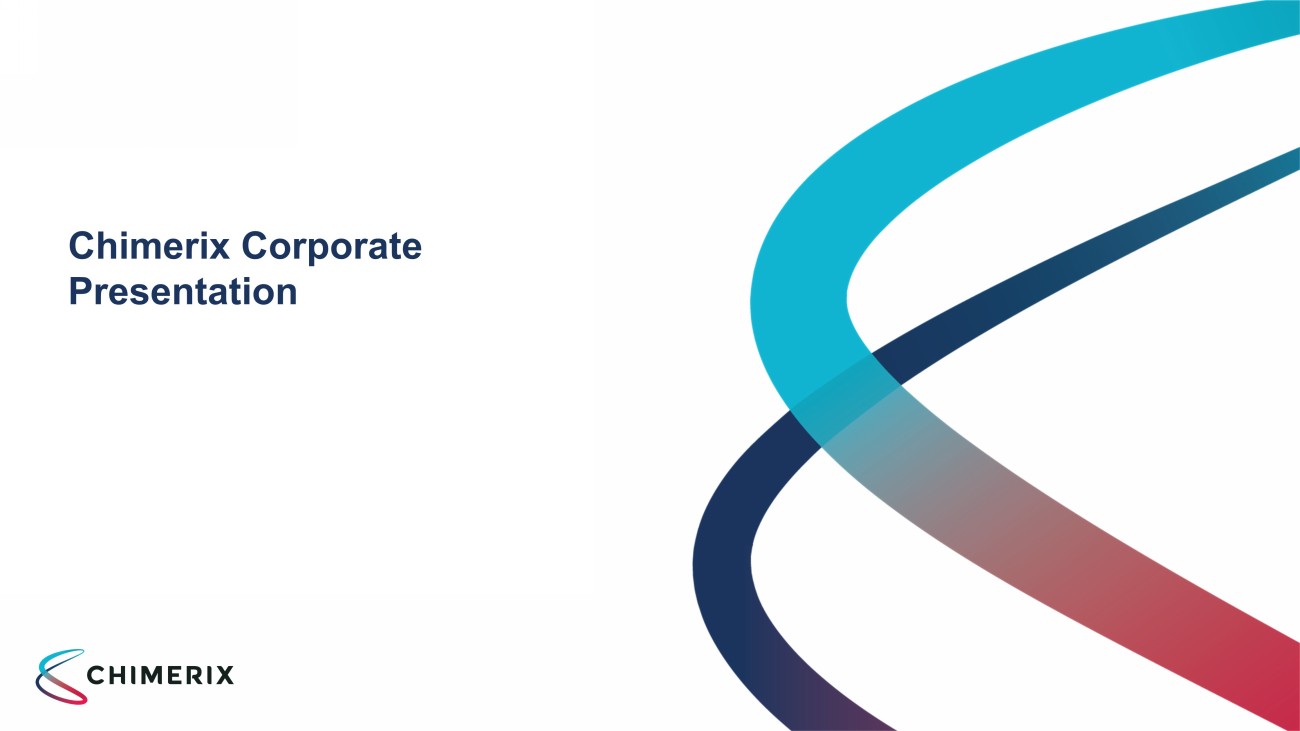
Chimerix Corporate Presentation




































